Hong Kong is home to more than 7.5 million people and its surrounding waters host around 5,900 marine species, including dolphins, porpoises and whales.
While encounters with these marine mammals are rare, they occasionally occur when their lifeless bodies are found …
Washed ashore
Every year, an average of 35 marine mammals are found washed up in Hong Kong’s coastal areas,
their carcasses often showing signs of injury, illness or some other trauma. By May 2025 alone,
18 cases had already been reported, which is slightly above the historical average for the first
five months of every year since 2006.
An analysis by the Post of over 670 recorded stranding incidents
from the past two decades highlights several trends, including shrinking populations of certain
marine species and increased threats from boats, fishing nets and pollution.
Explore this infographic to learn more about Hong Kong’s marine mammals and the dangers they face.
Dolphins, porpoises and whales (cetaceans)
At least 17 species of cetaceans, including dolphins, porpoises and whales, have been found washed ashore in Hong Kong. Of these, only two - the finless porpoise and the Chinese white dolphin - are native to Hong Kong and nearby waters, and account for most of the stranding cases. The others are transient visitors.


What do they eat?
The diet of these cetaceans includes at least 20 species of small fish, along with various cephalopods and shrimp. Some commonly consumed species include:

Stranding locations
Cetacean strandings can occur in areas near their natural habitats or along migratory routes.
Species with higher populations in nearby waters are more likely to strand on local shores, but transient species may also wash up.
Chinese white dolphins, which are typically found in the western waters of Hong Kong, have been found
stranded in the southwest of the New Territories and the west side of Lantau Island.
Finless porpoises, inhabiting the southeastern waters of Hong Kong, have been found stranded
in areas such as Yan Chau Tong, Sai Kung, Clearwater Bay, and the southern part of Hong Kong Island.
Cetacean strandings in Hong Kong waters (since 2006)
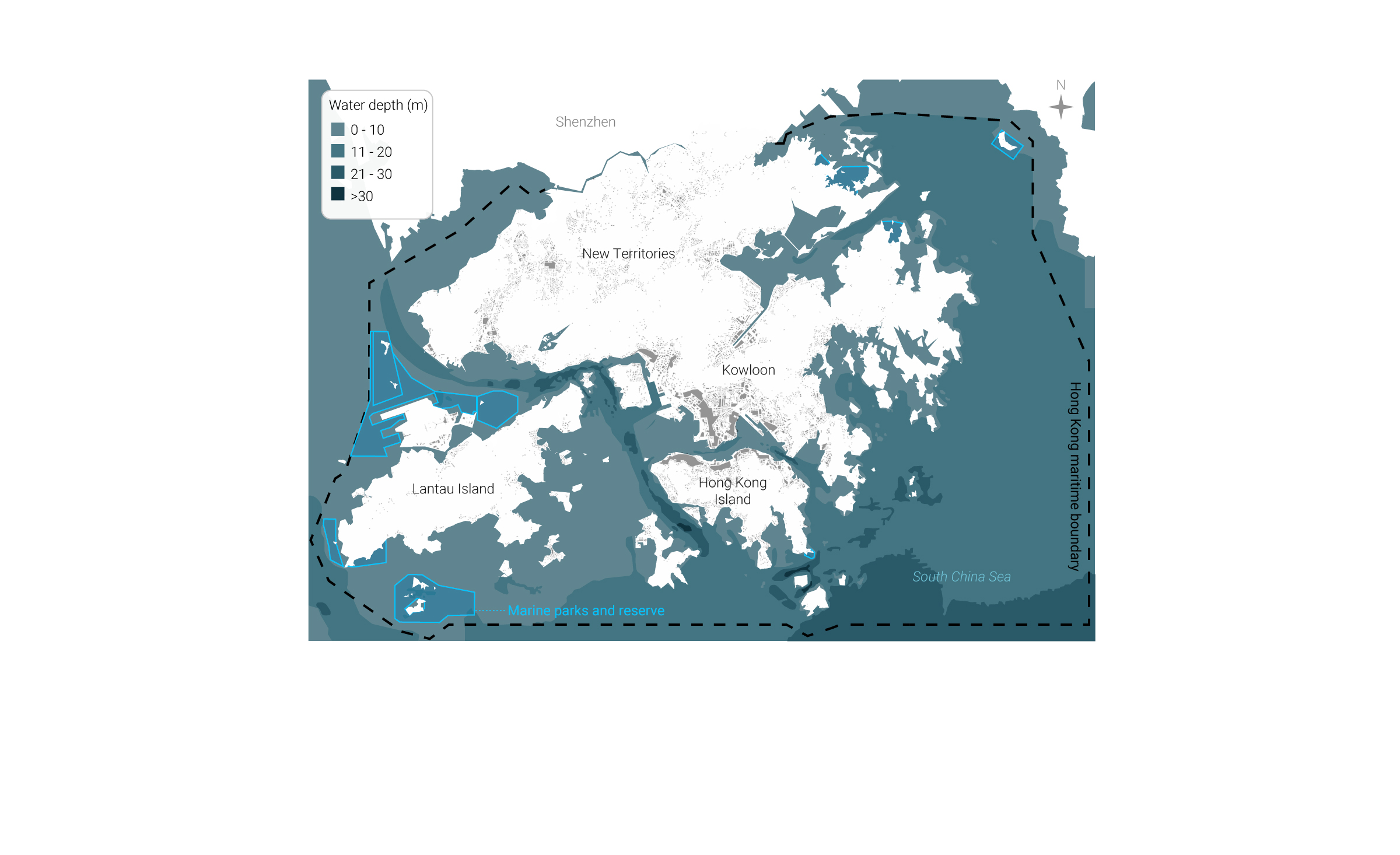

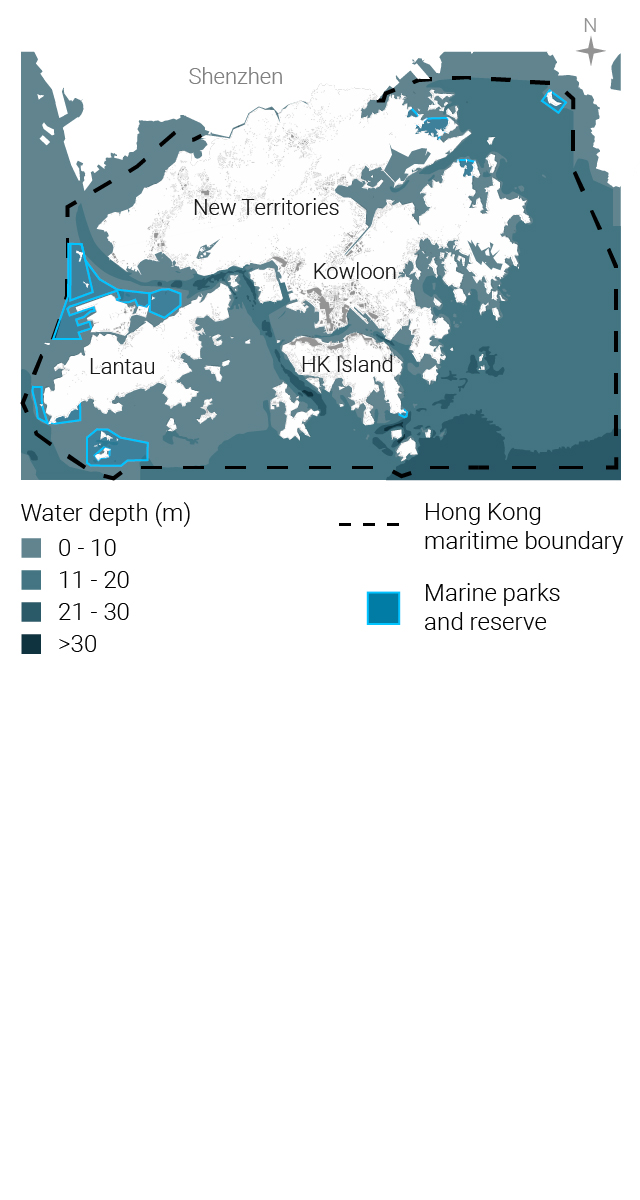



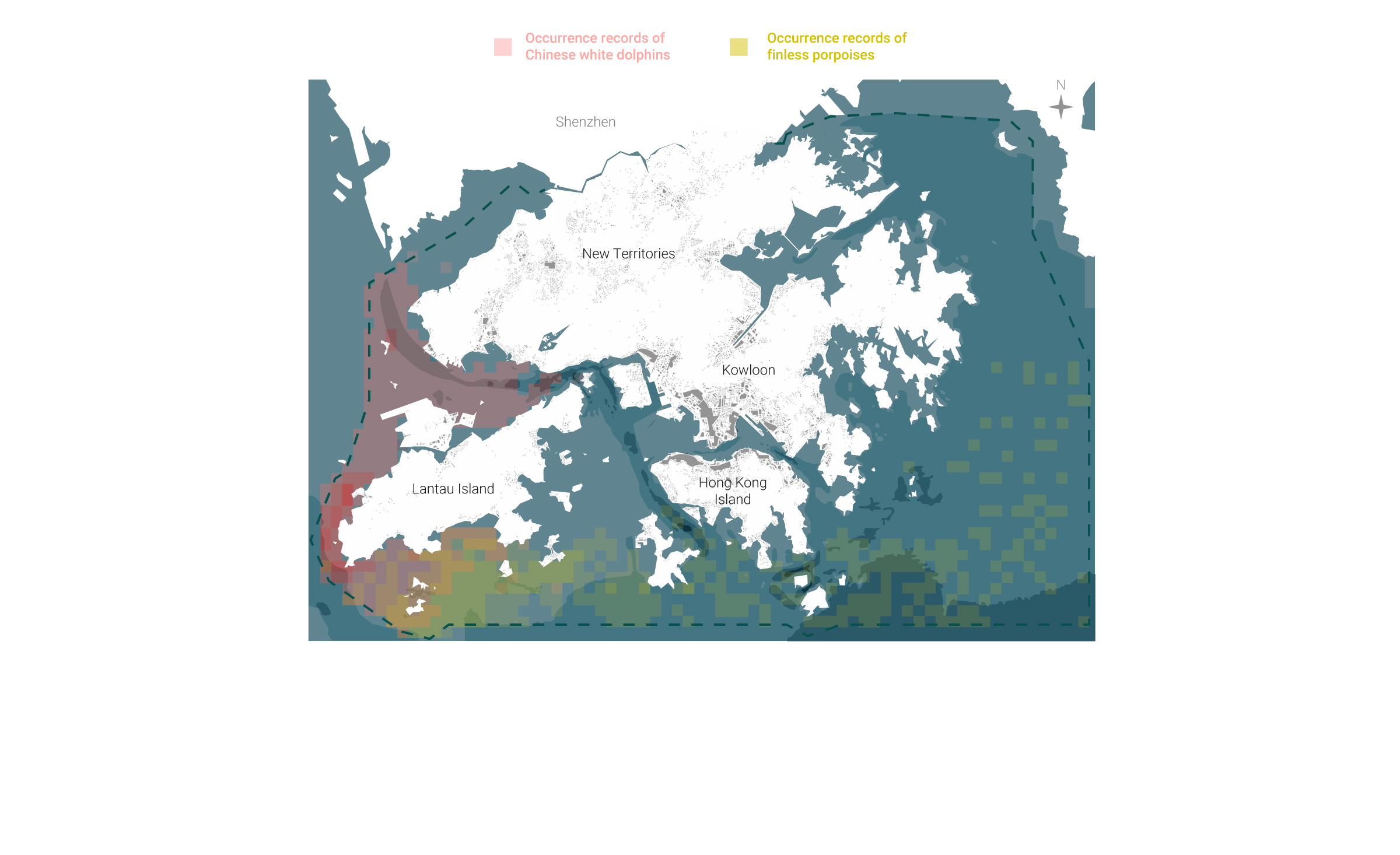

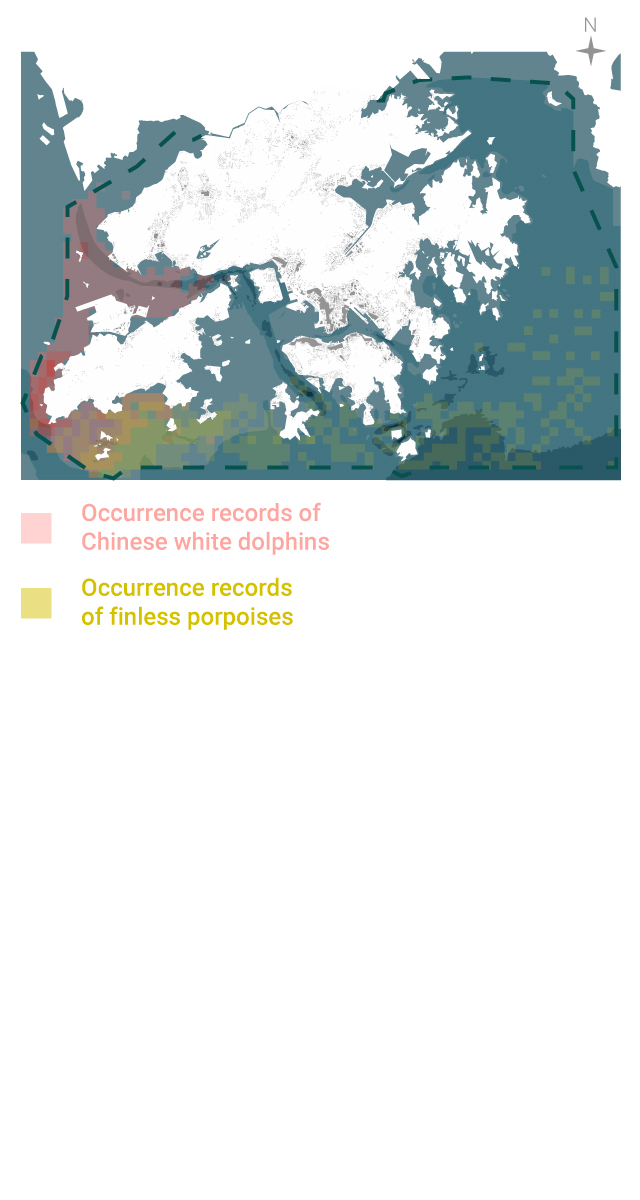
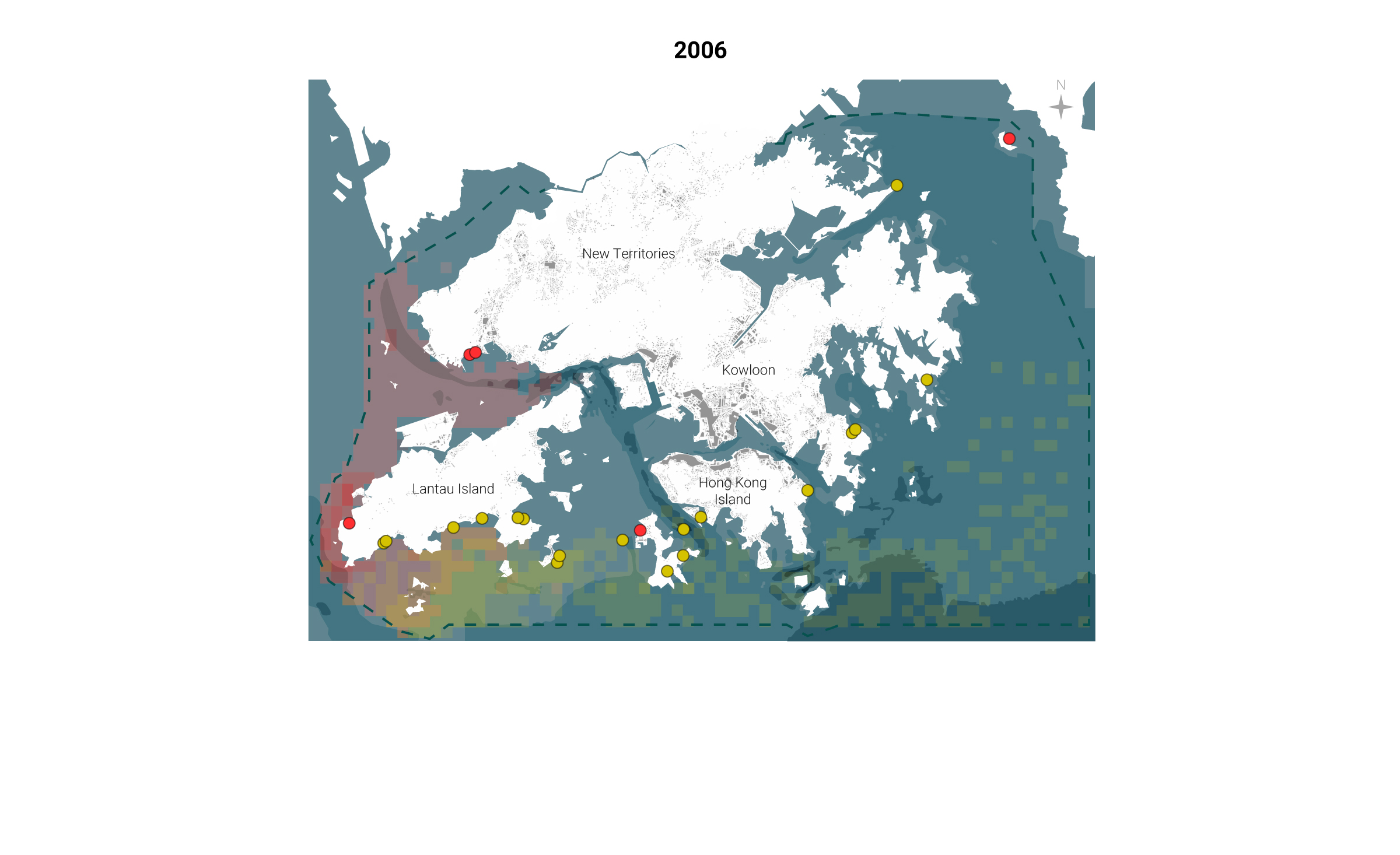

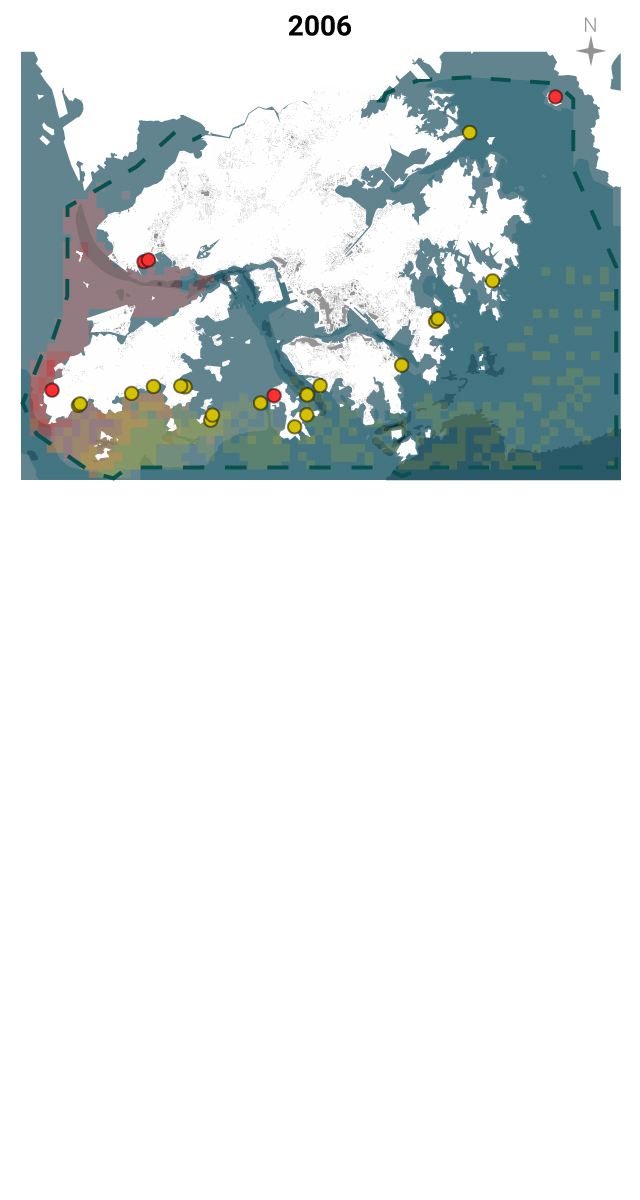
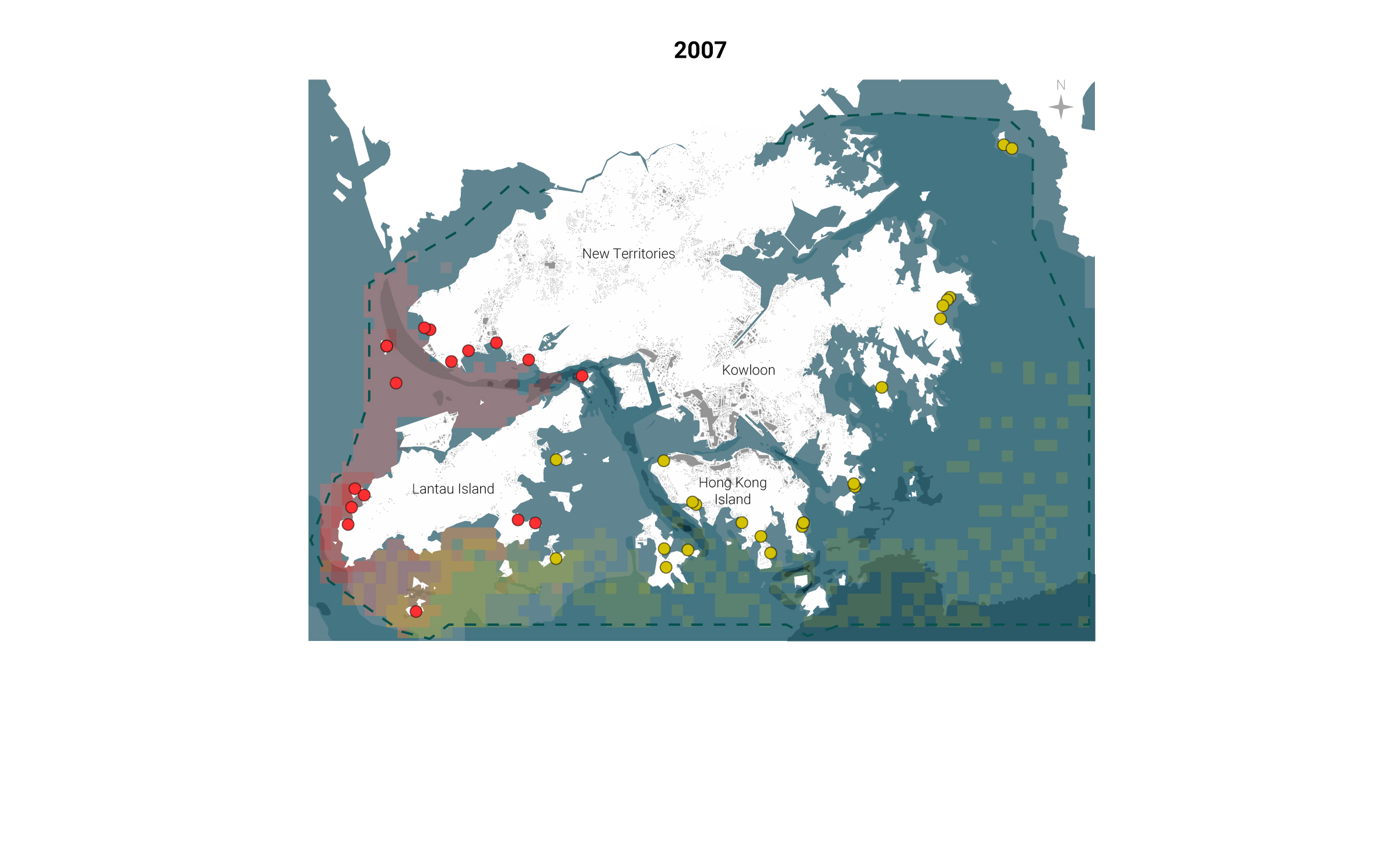

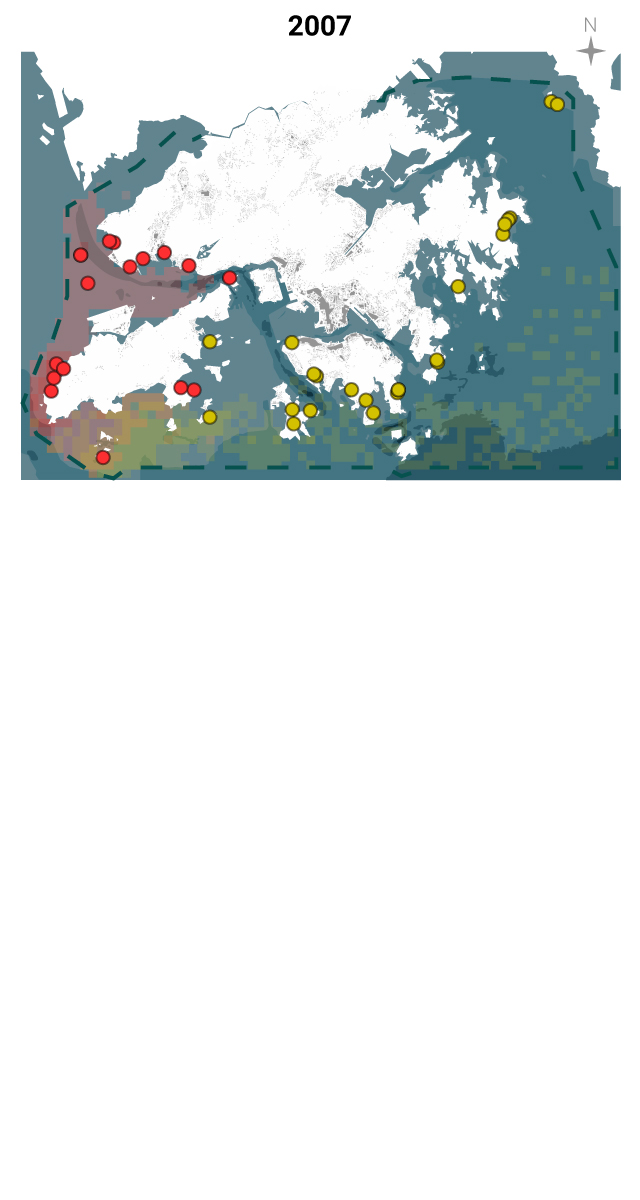


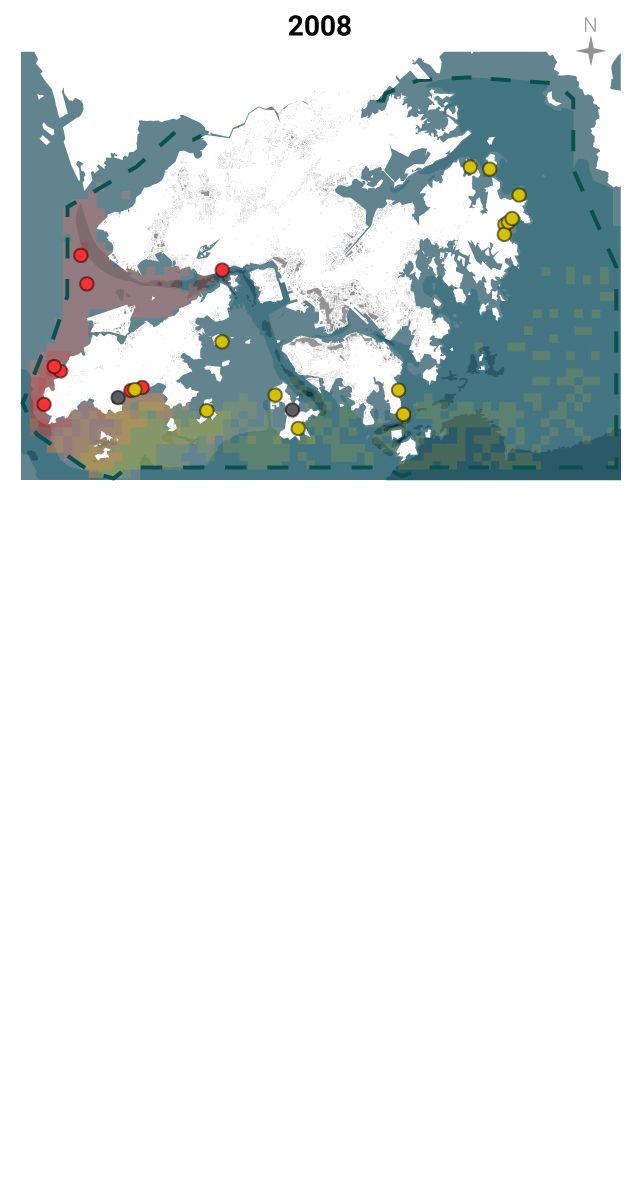
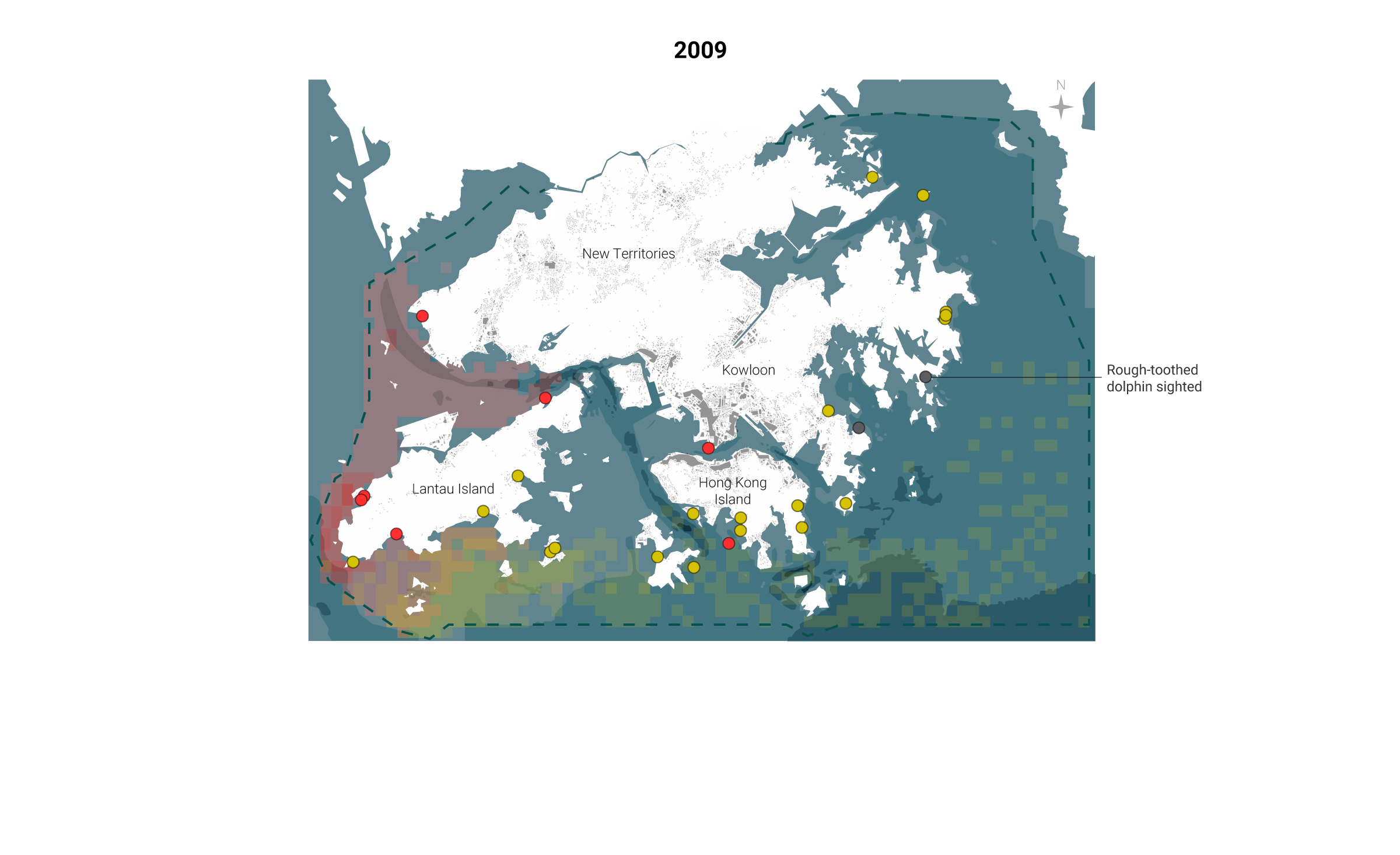

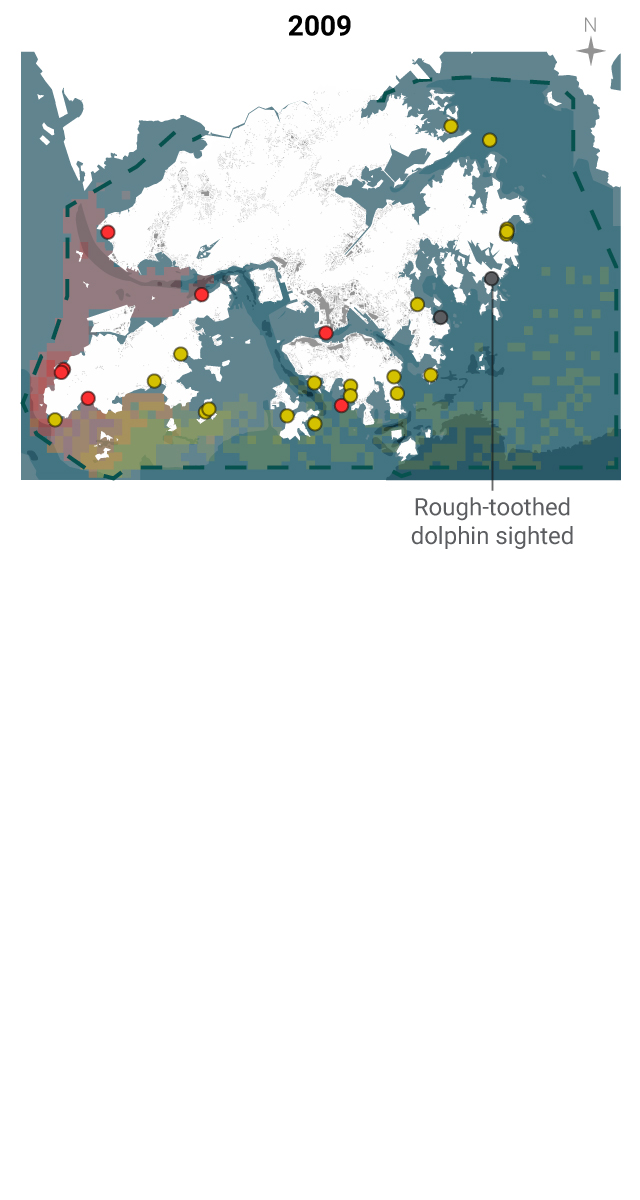



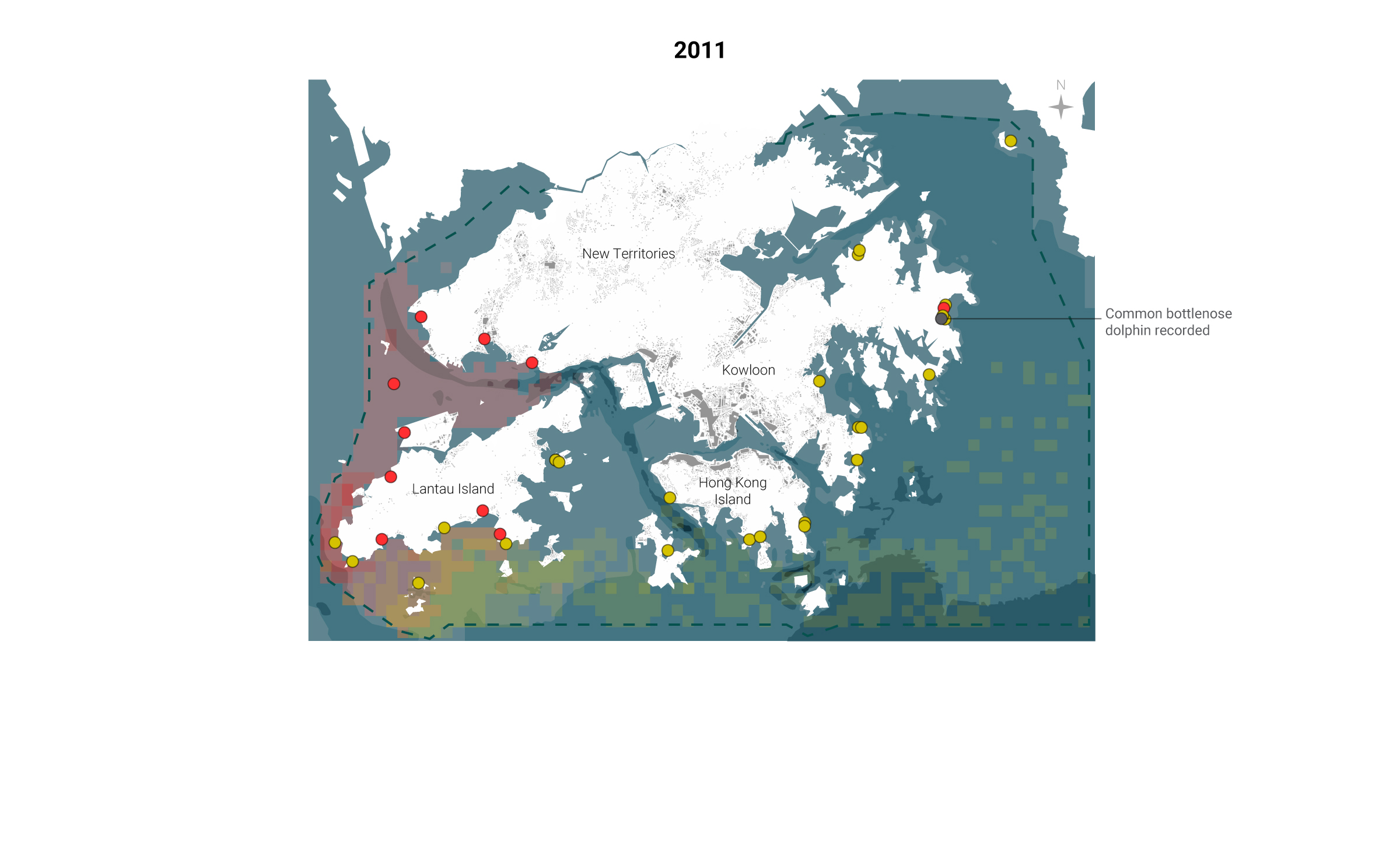

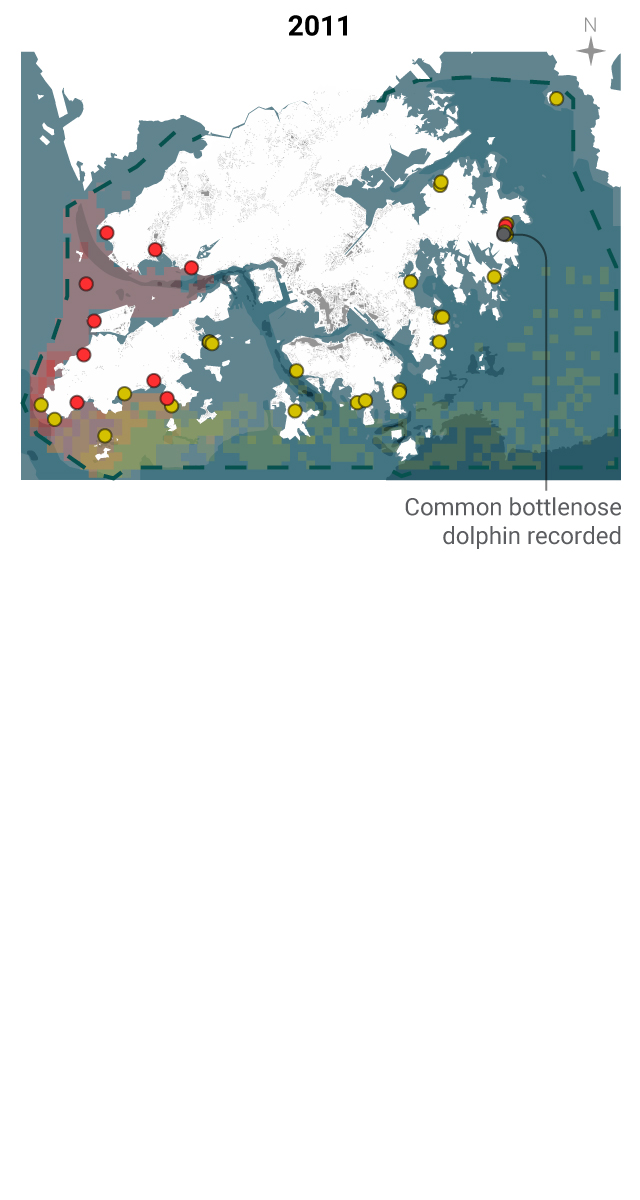
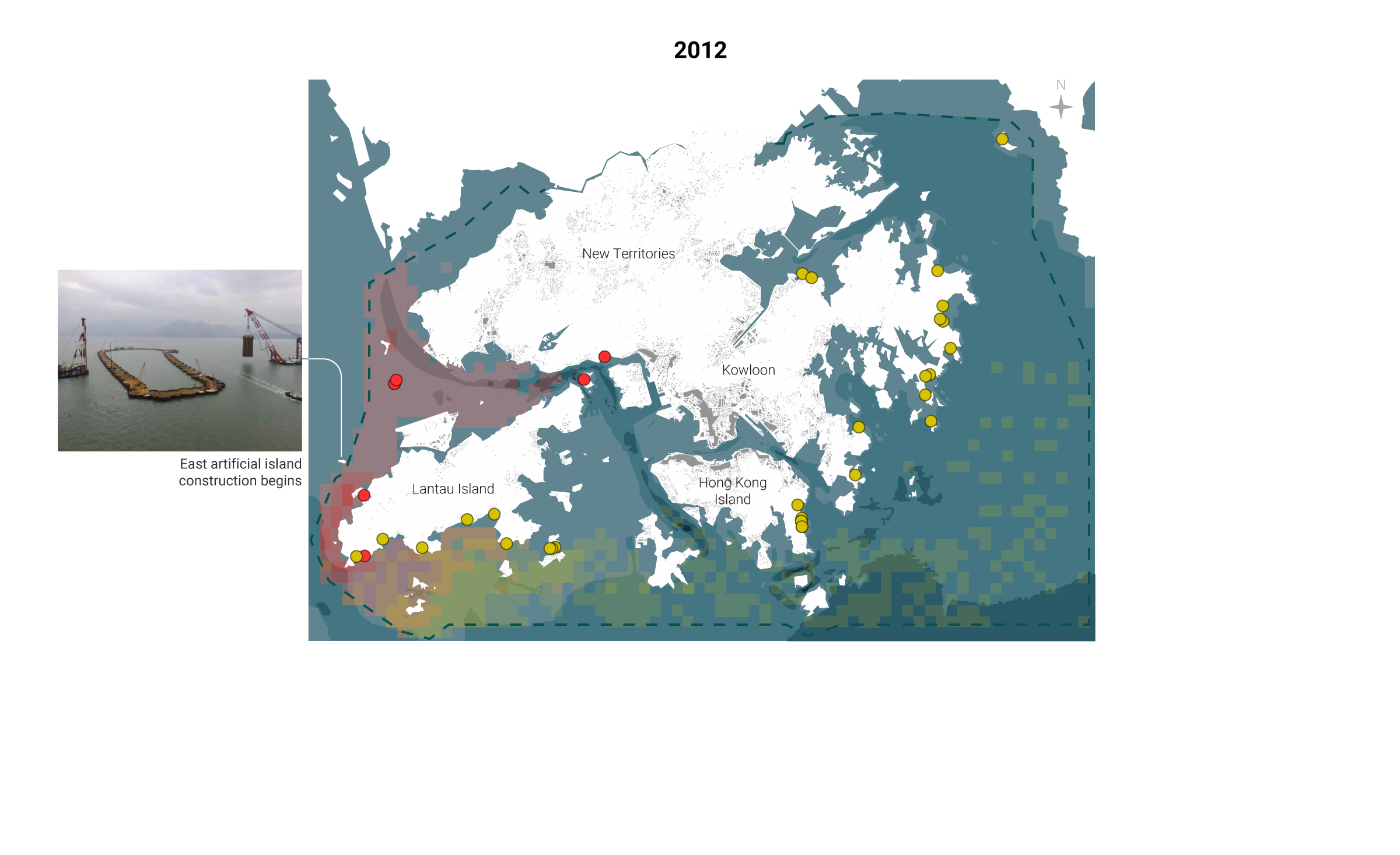


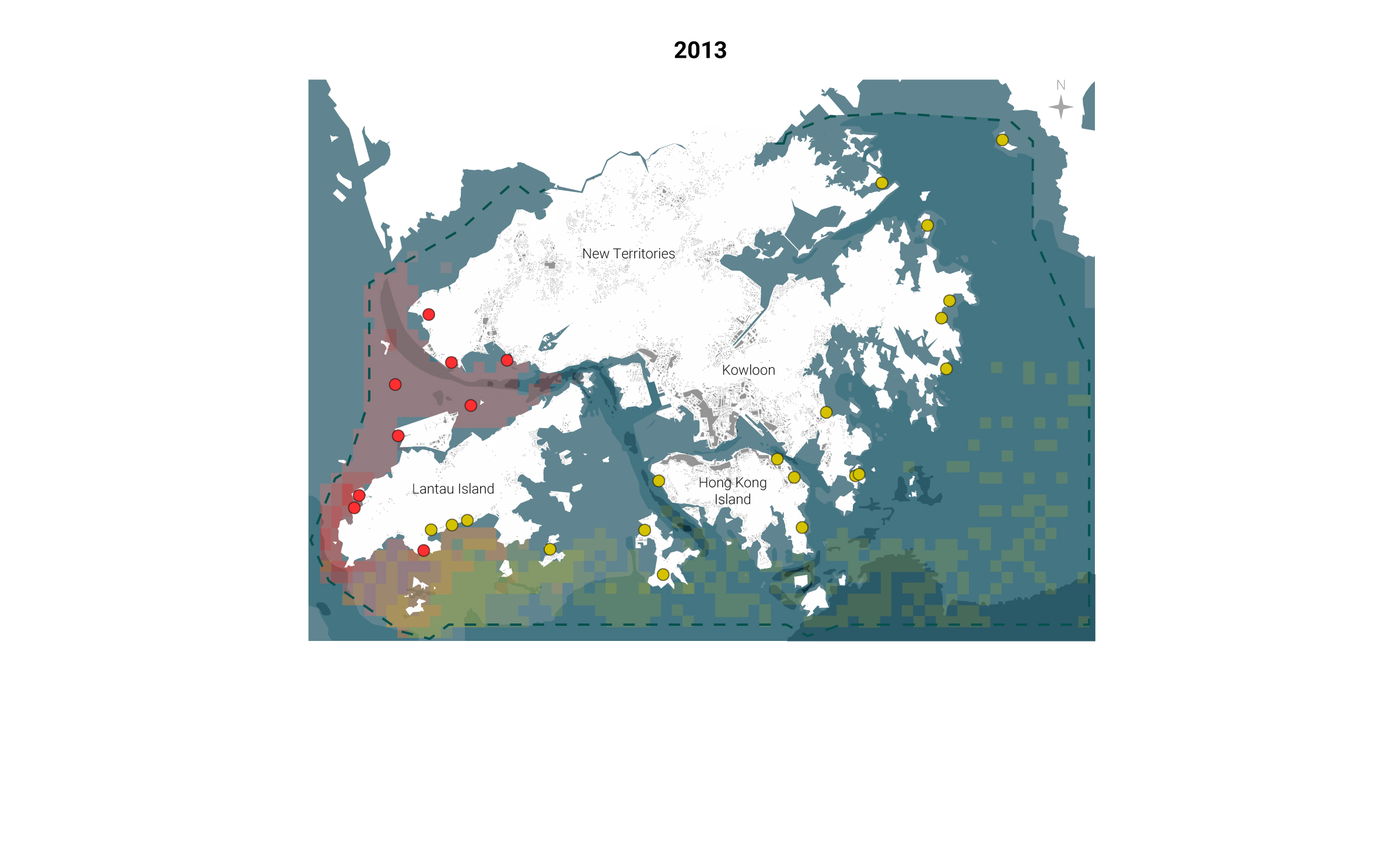

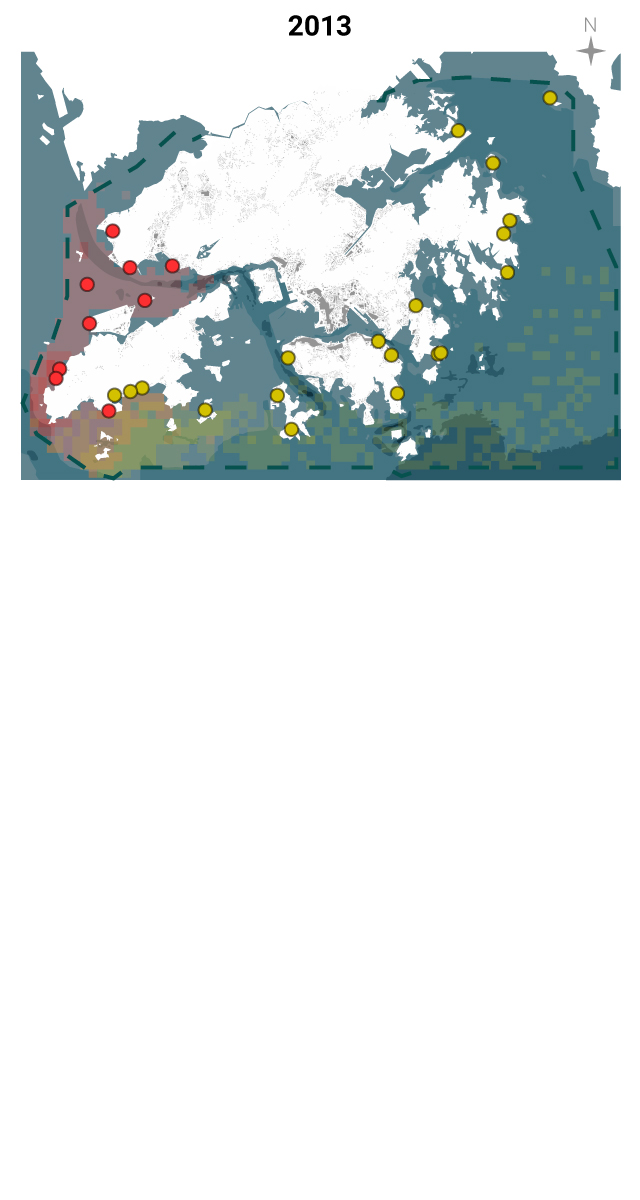
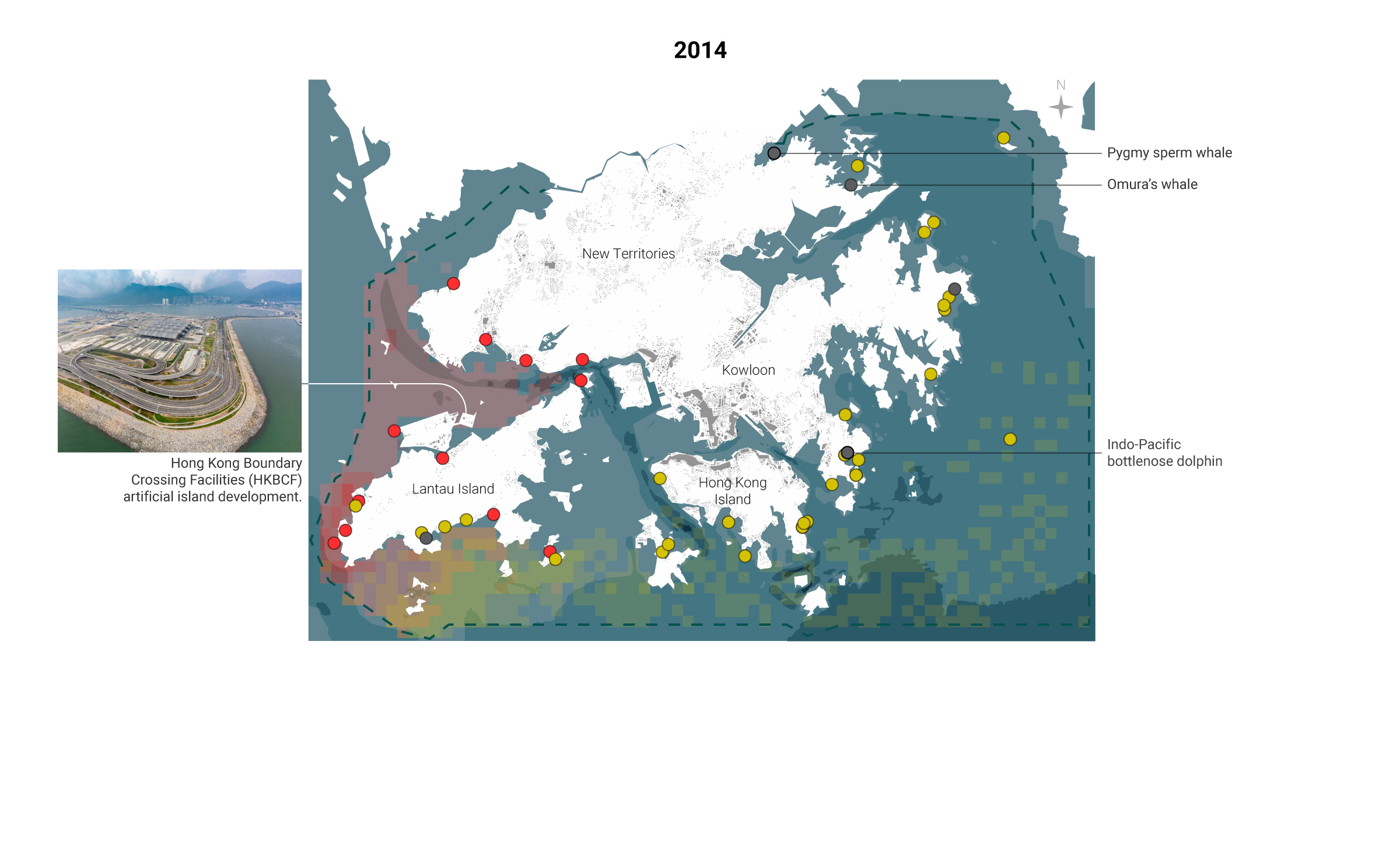

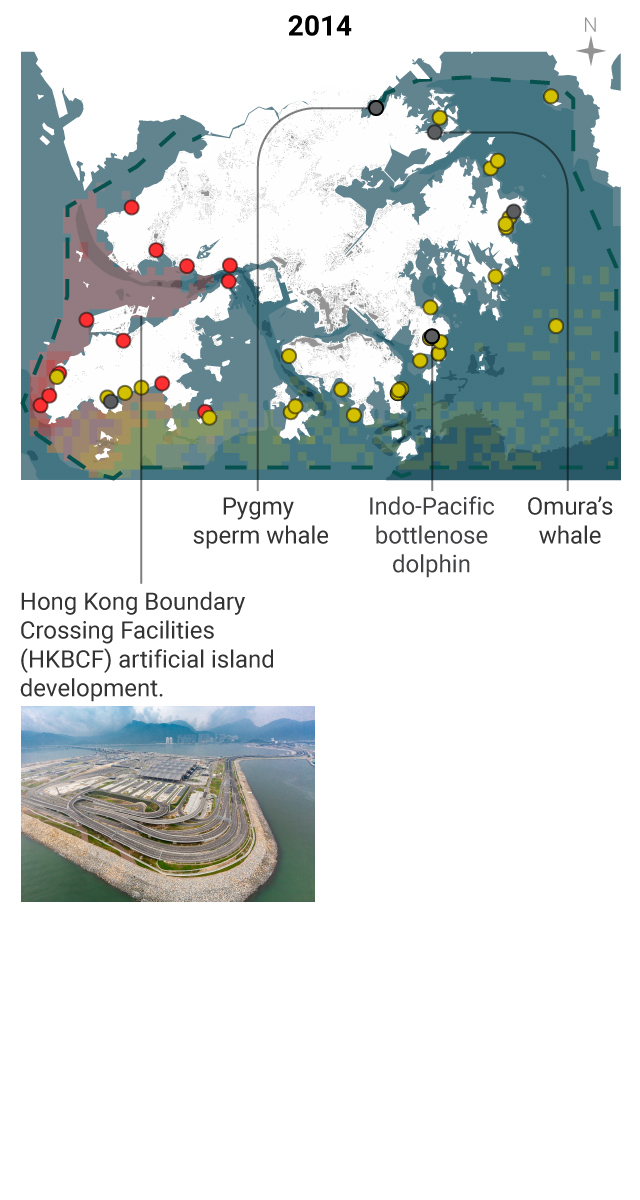
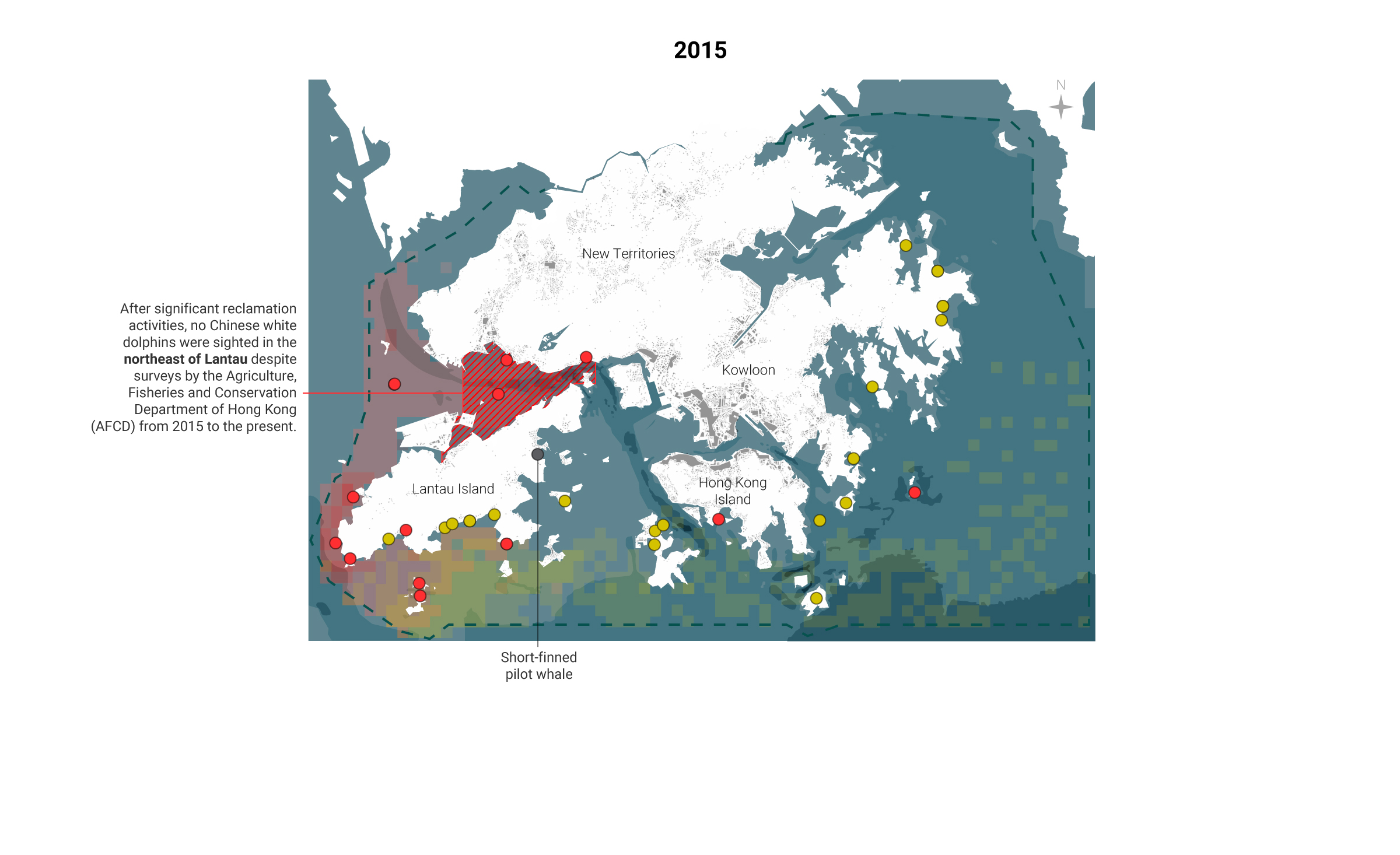

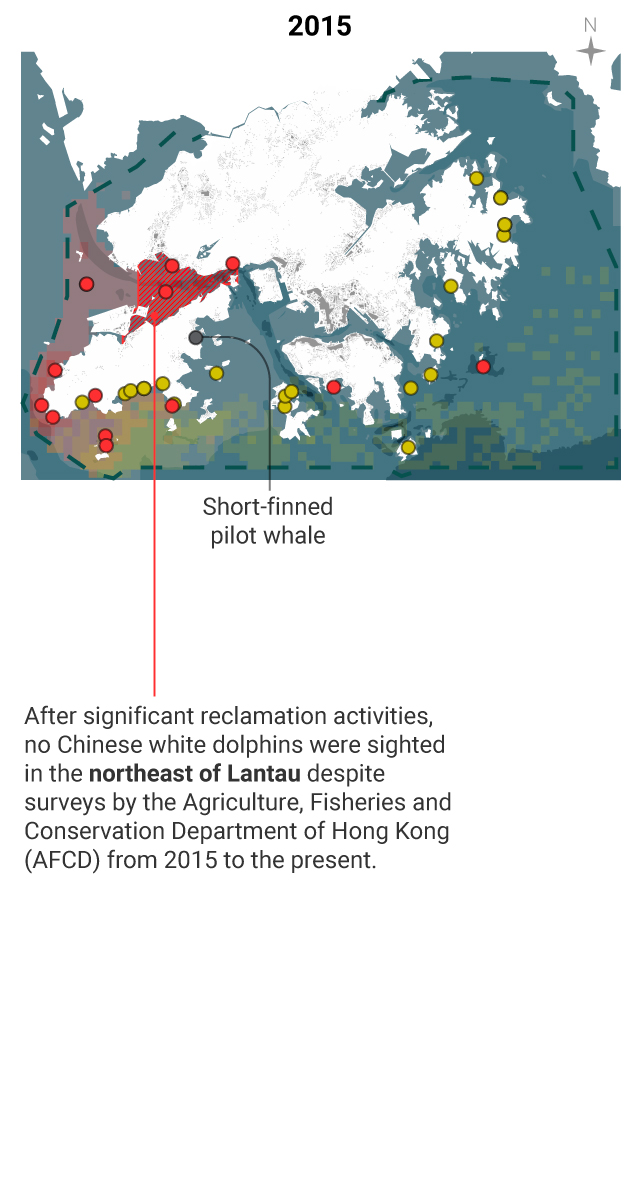


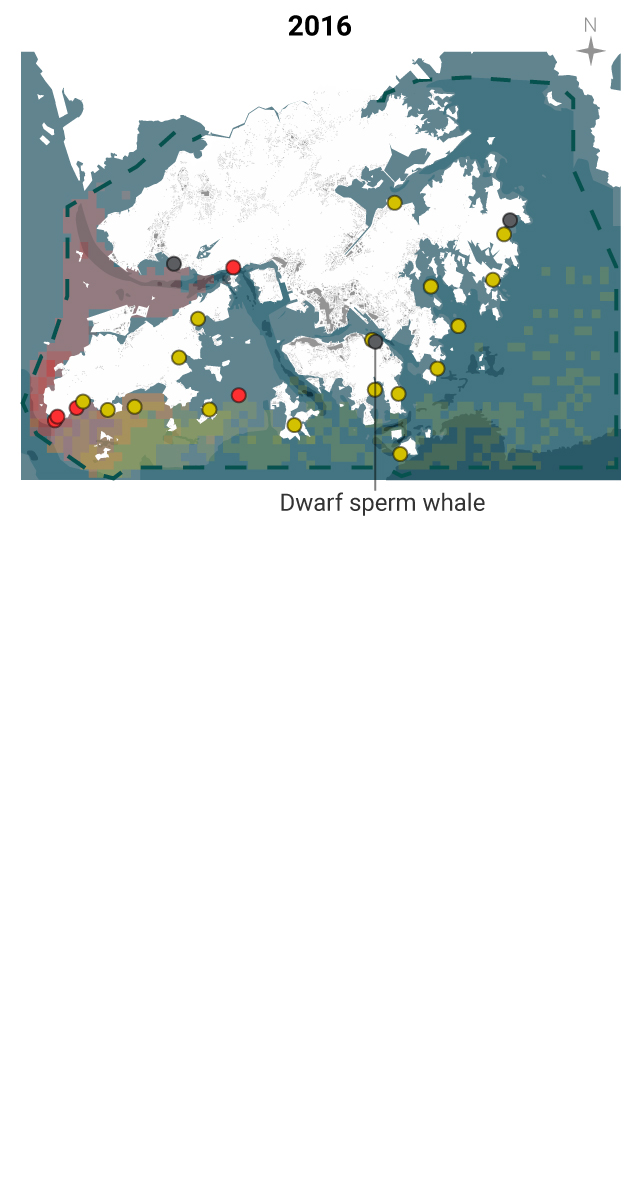
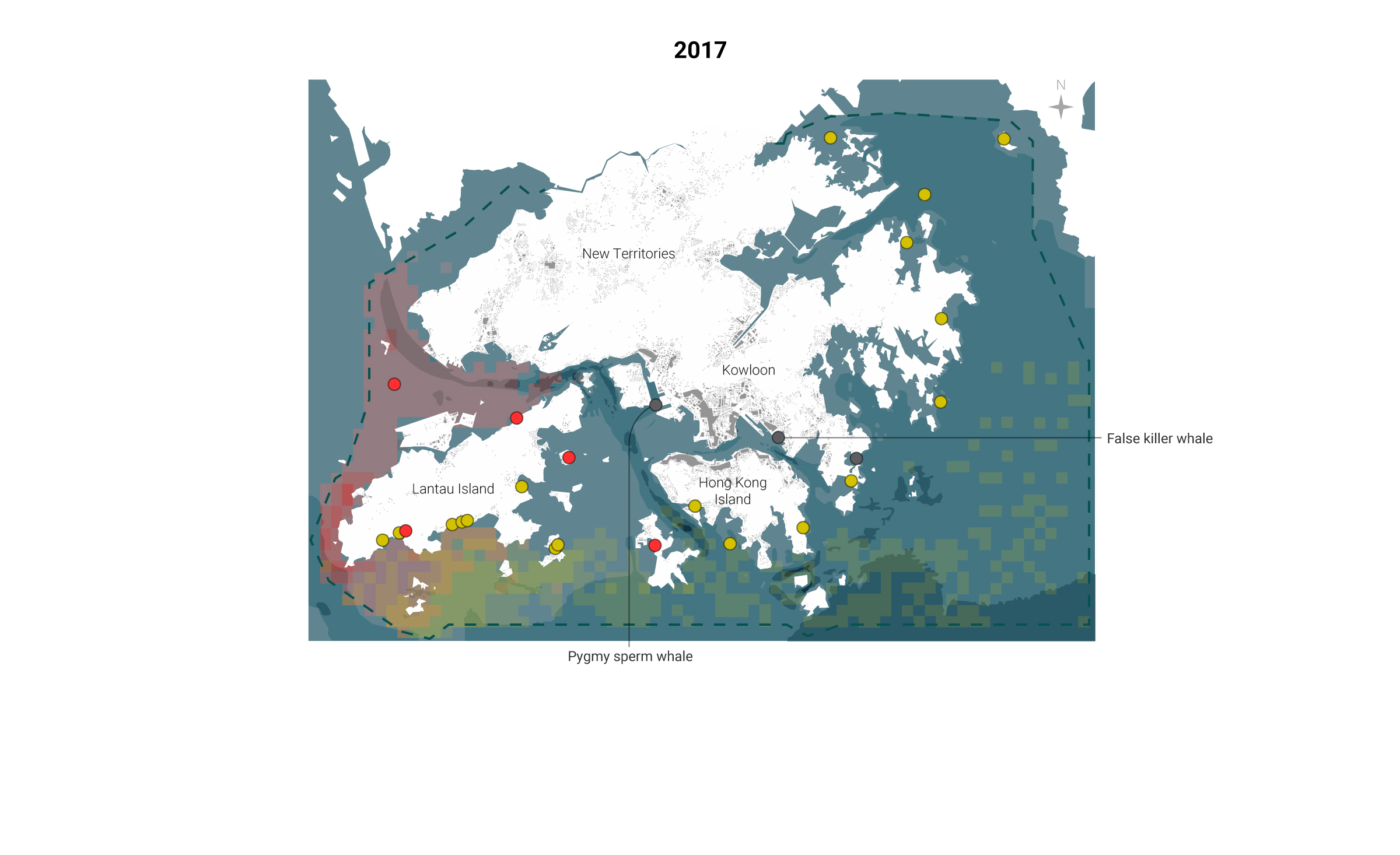

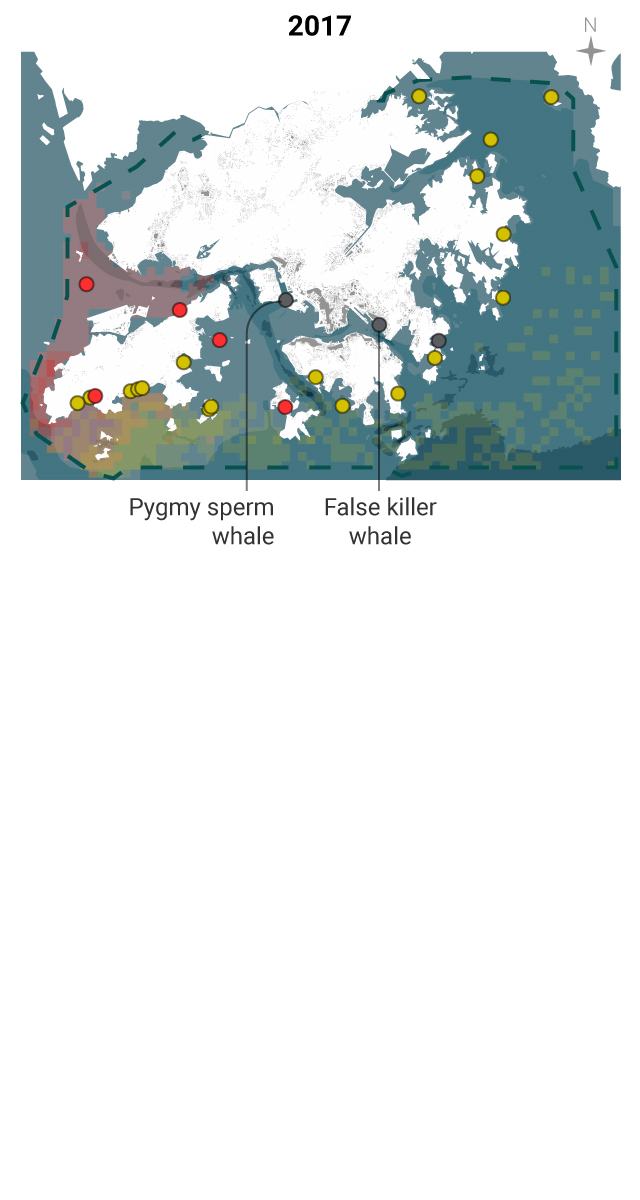
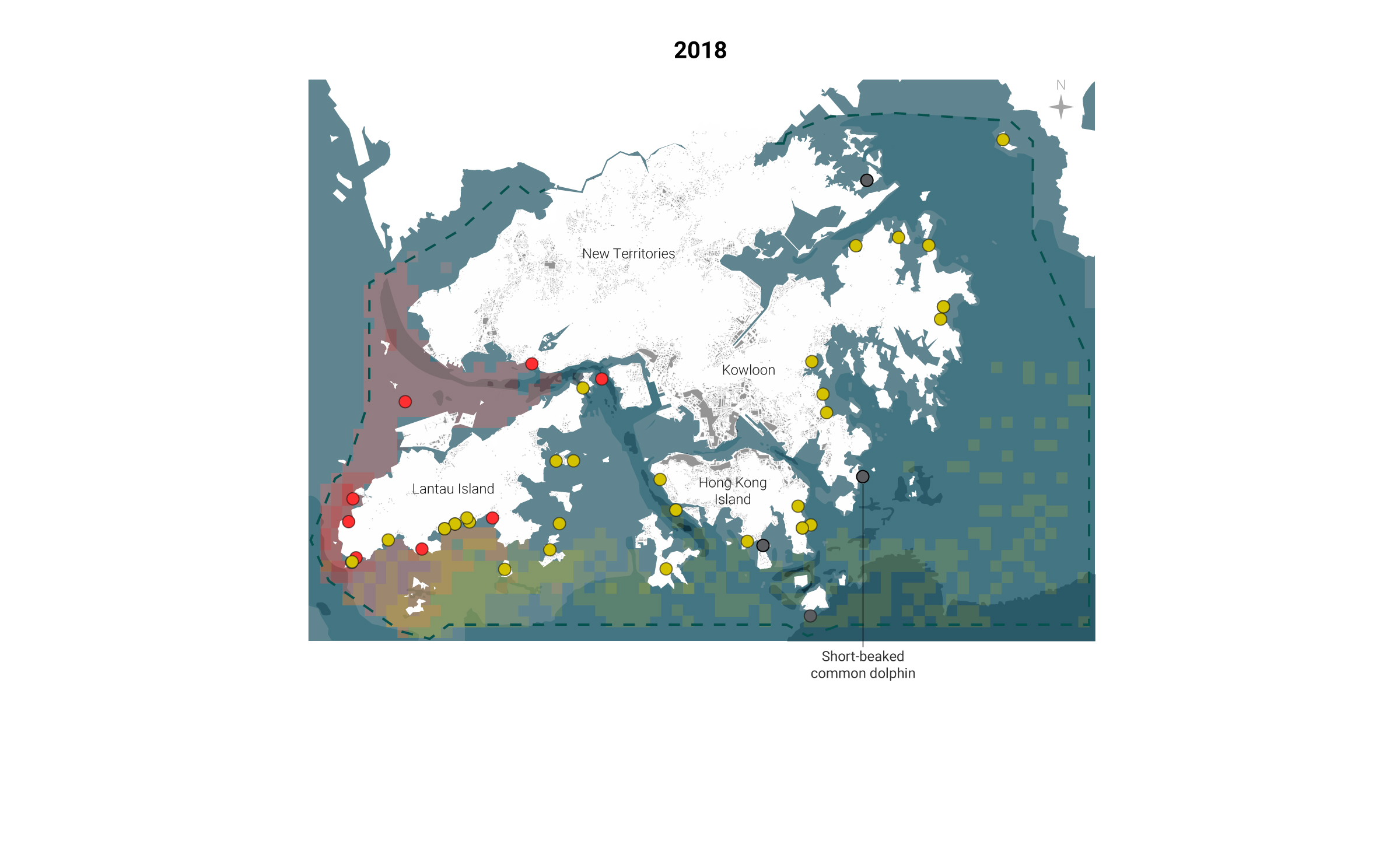

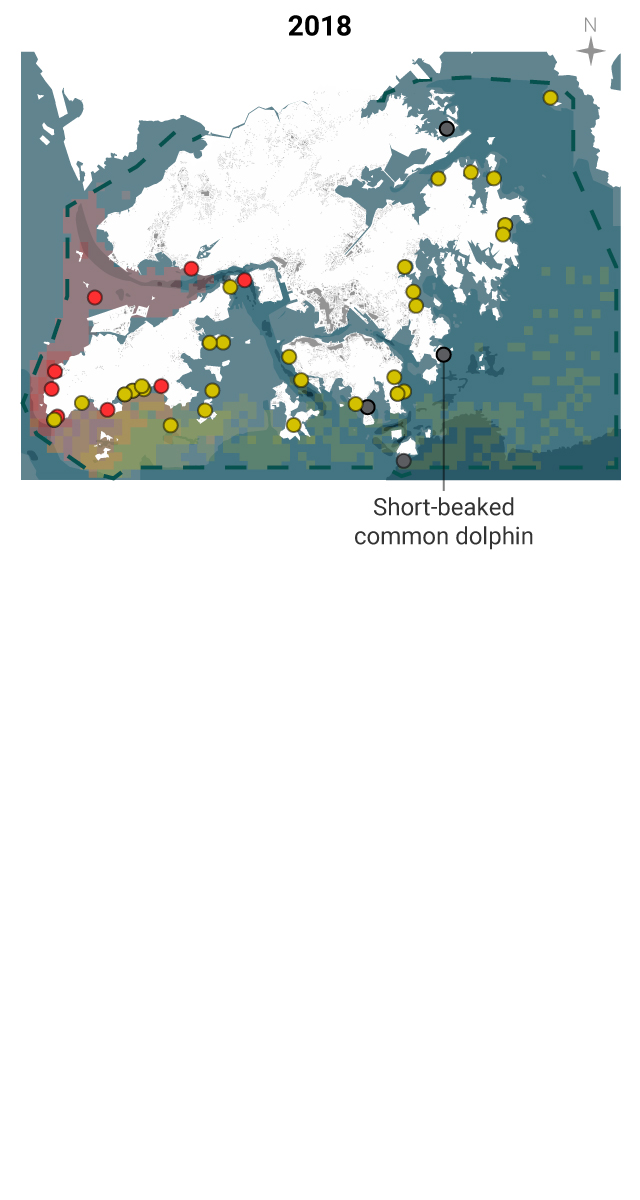
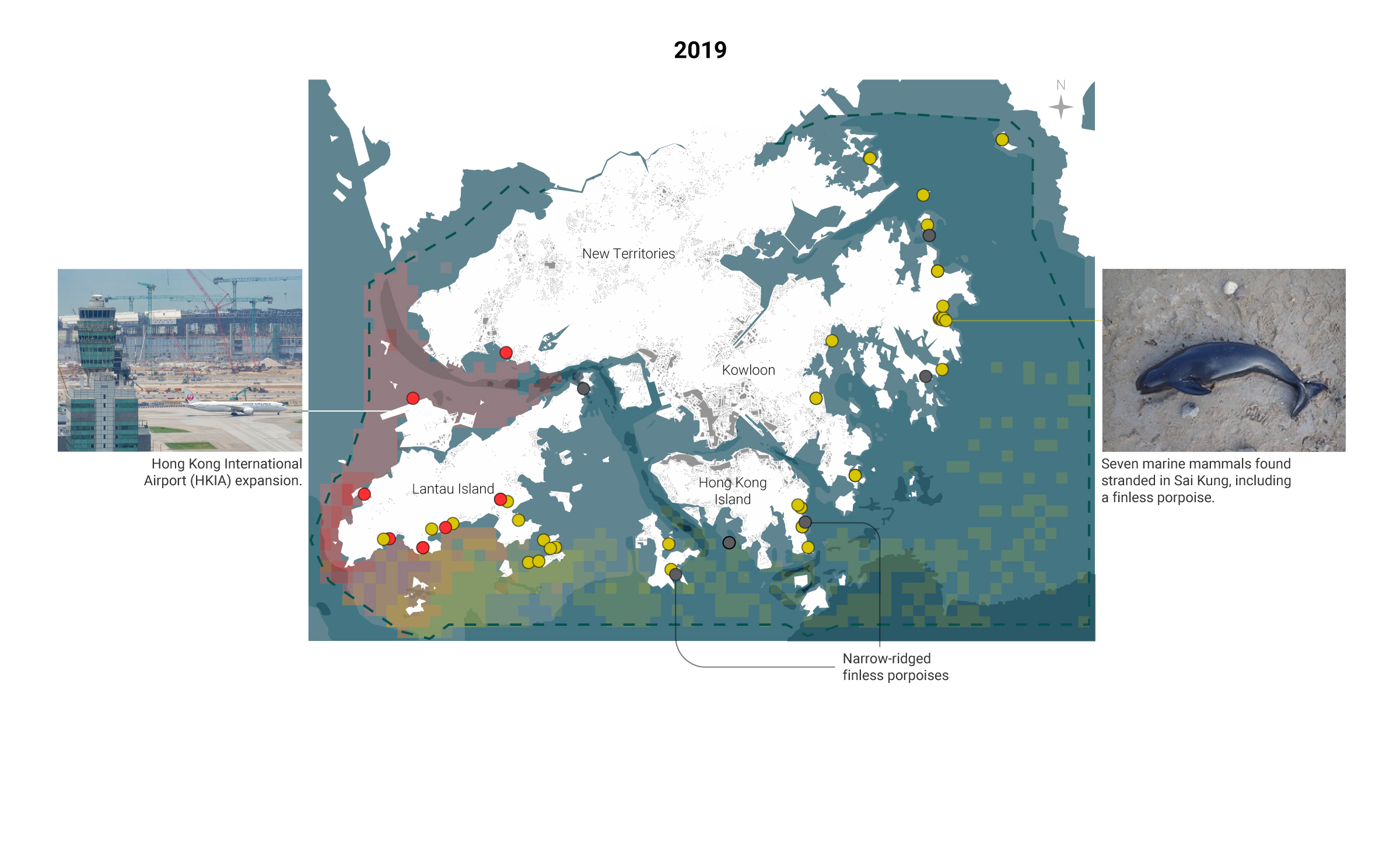

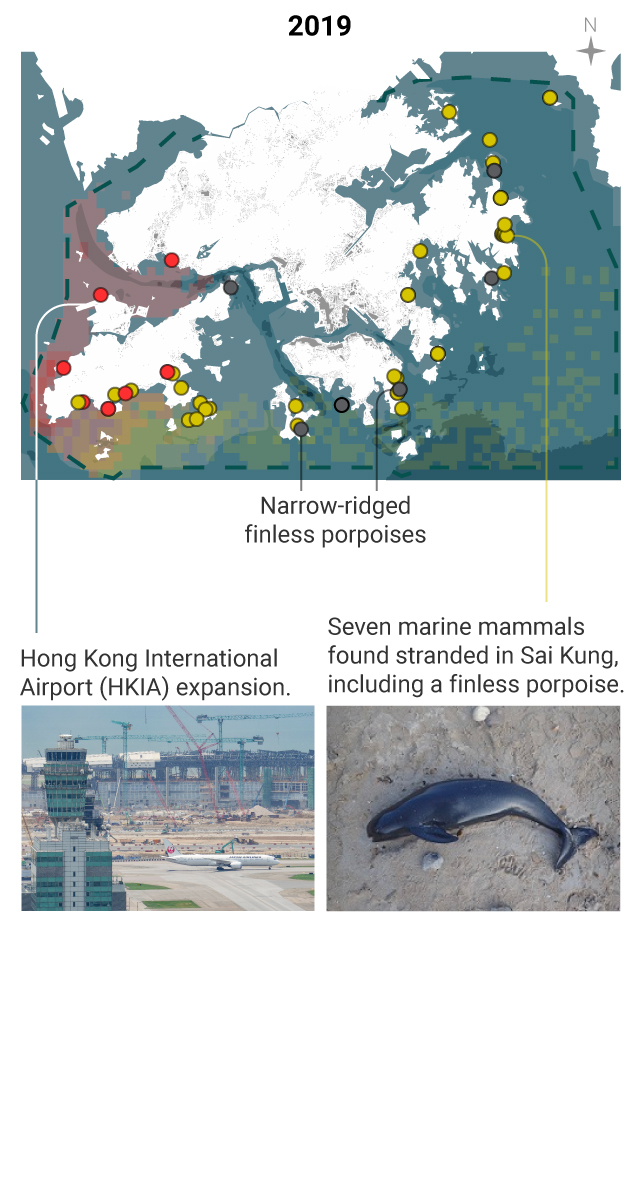
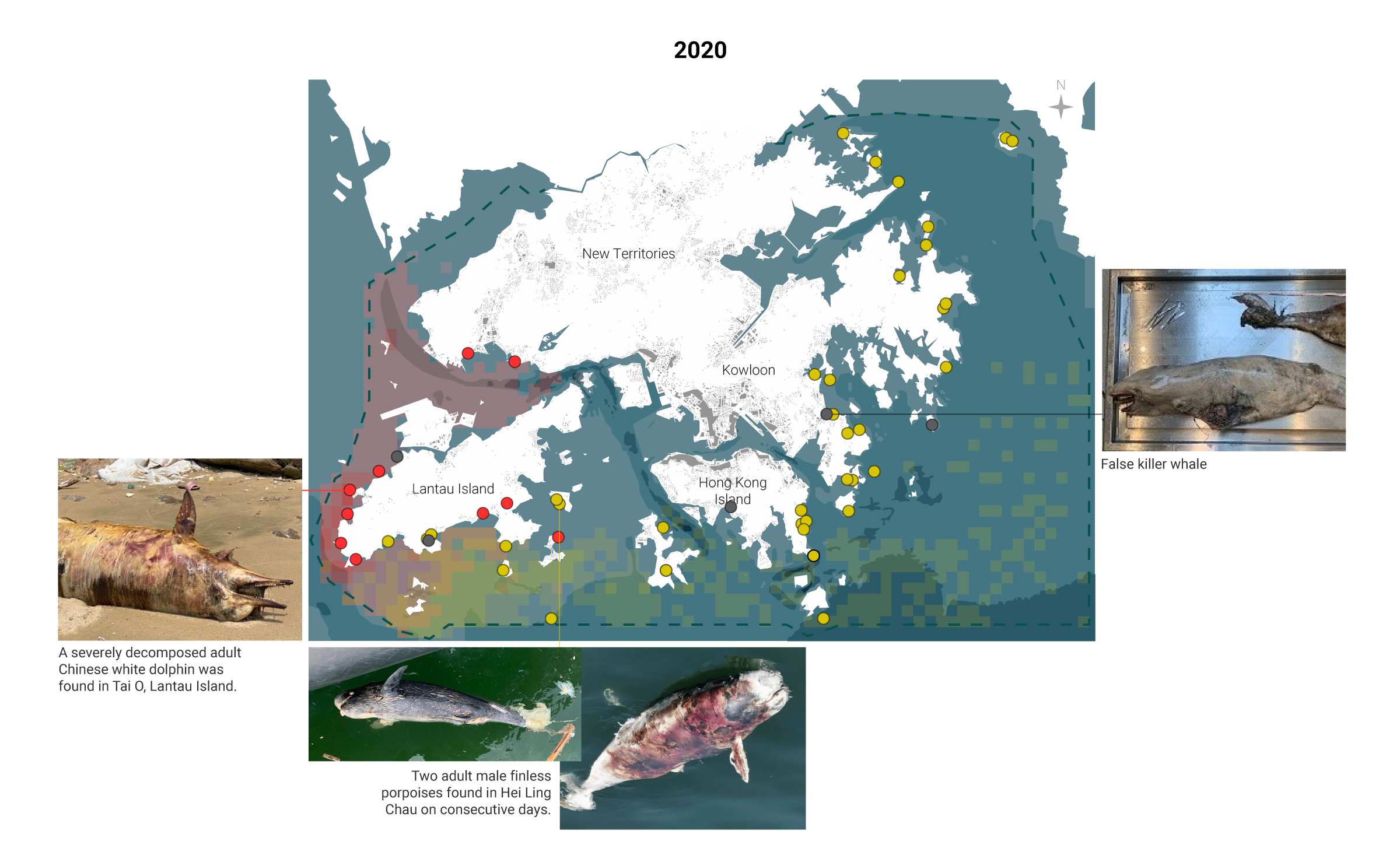

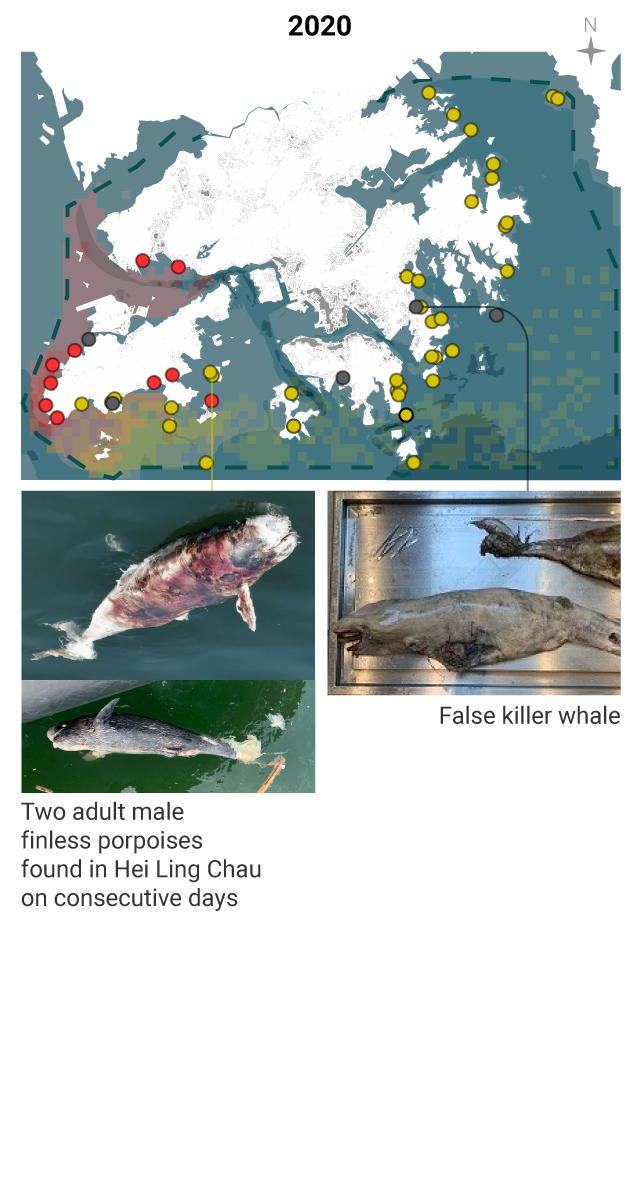
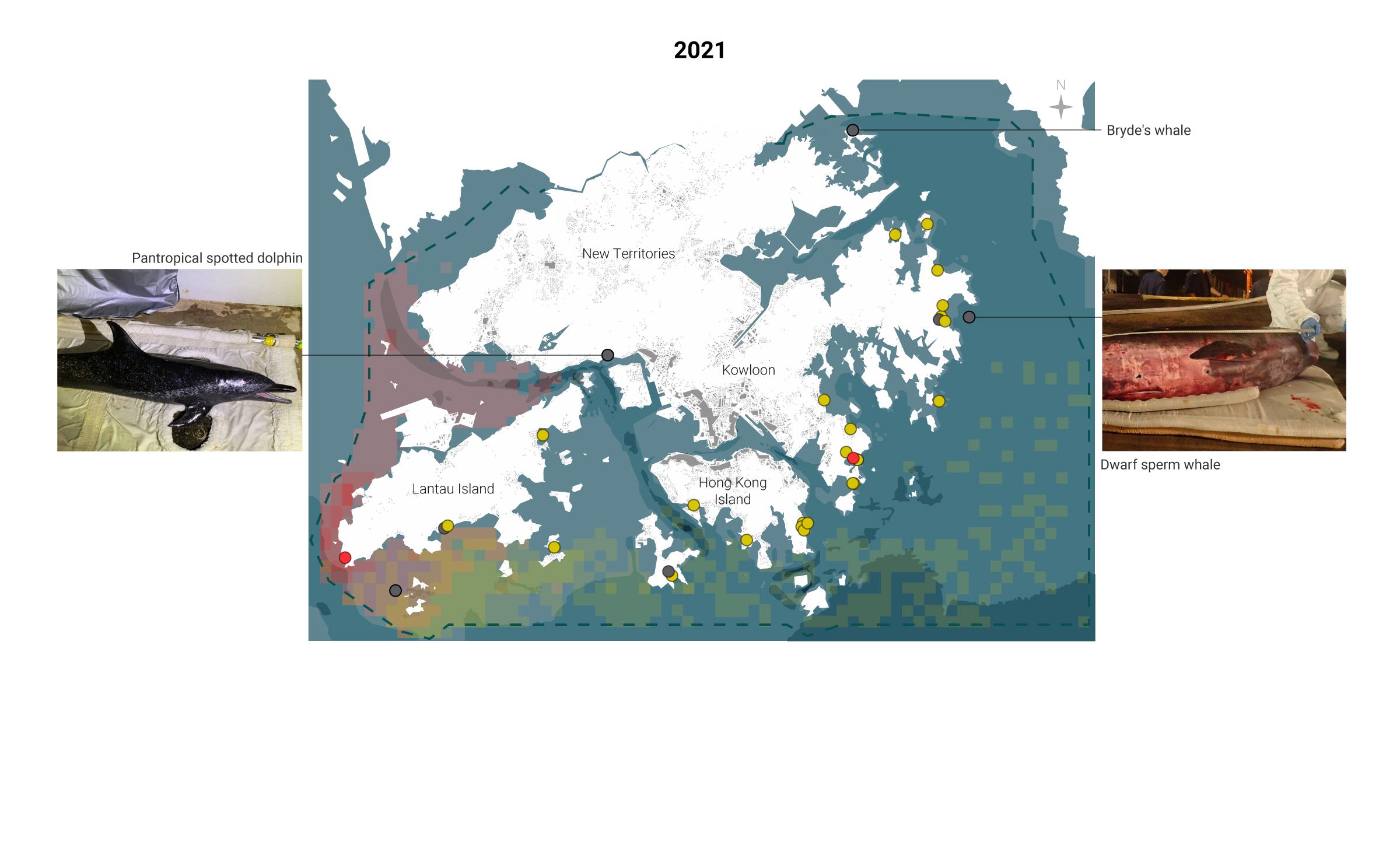


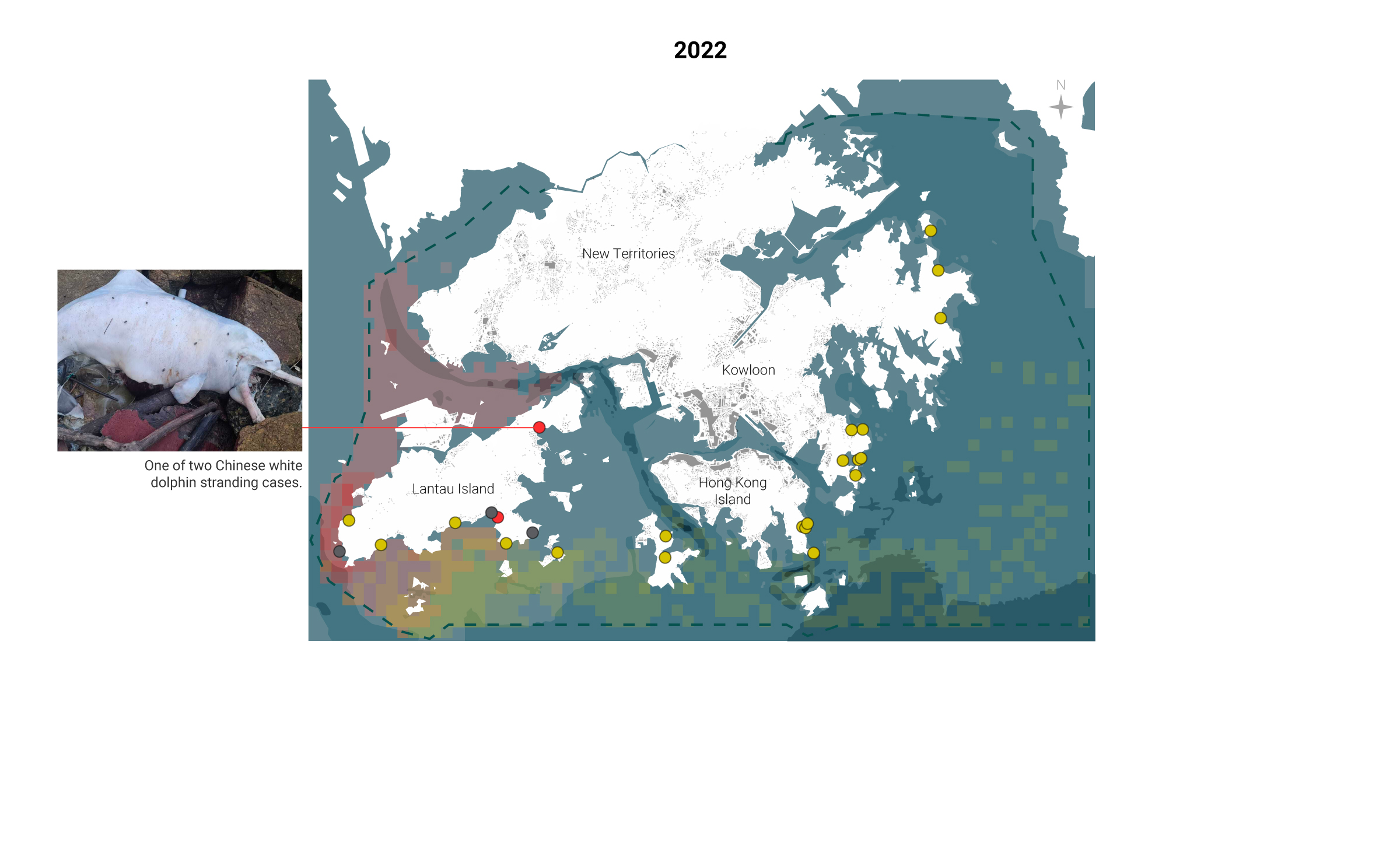

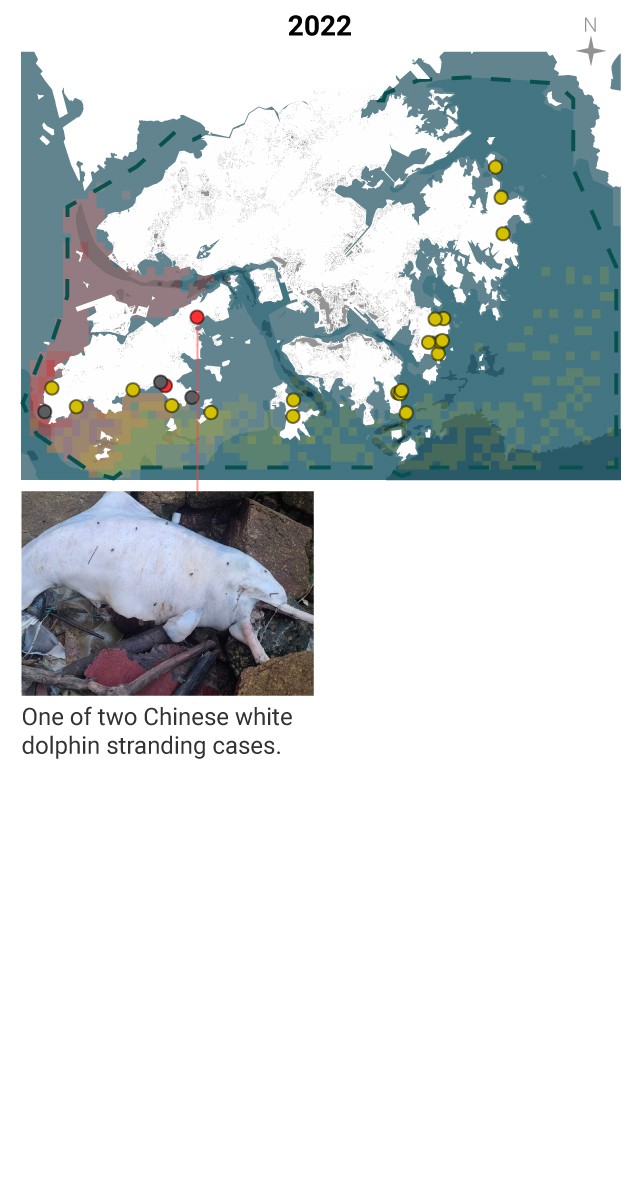
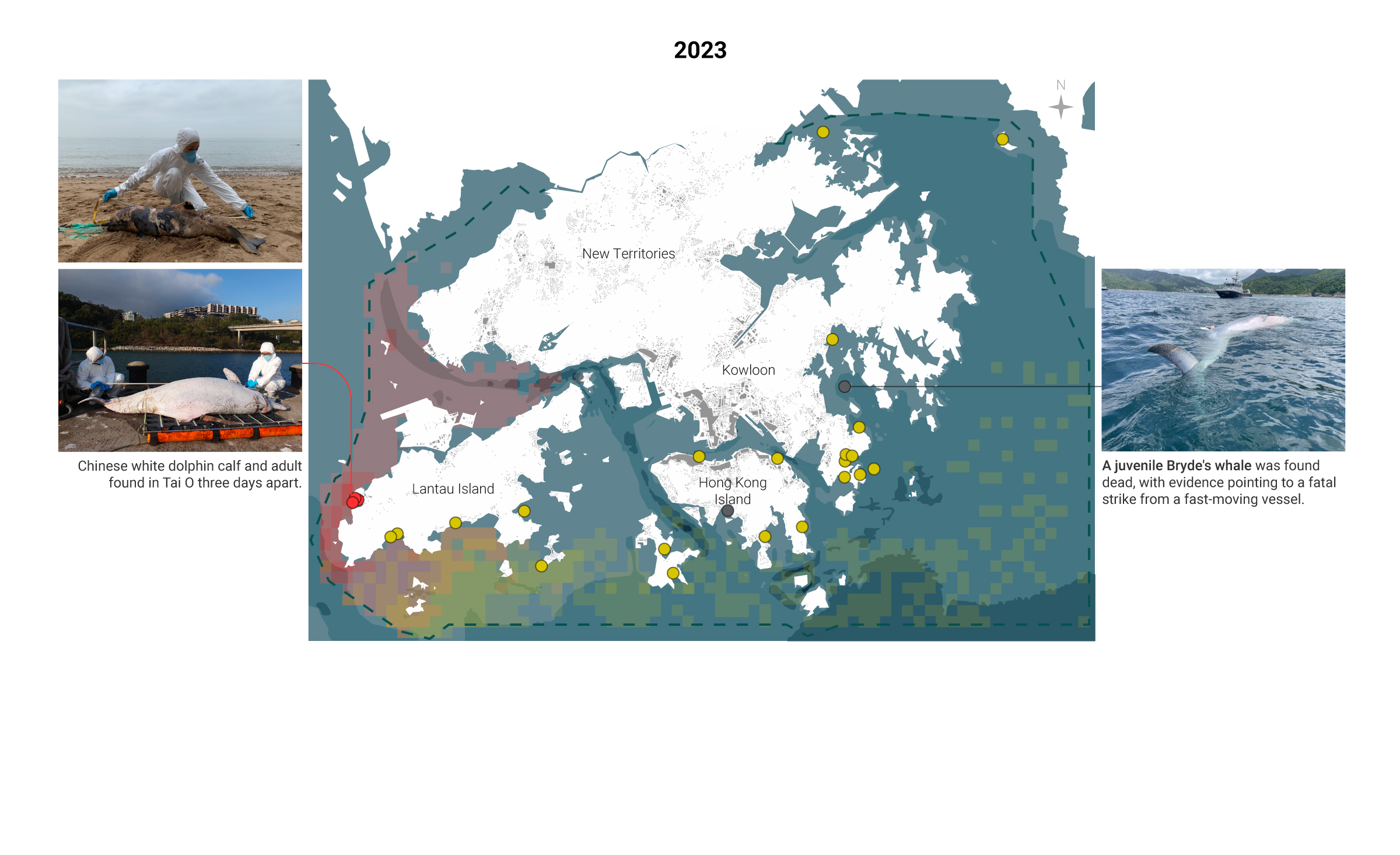

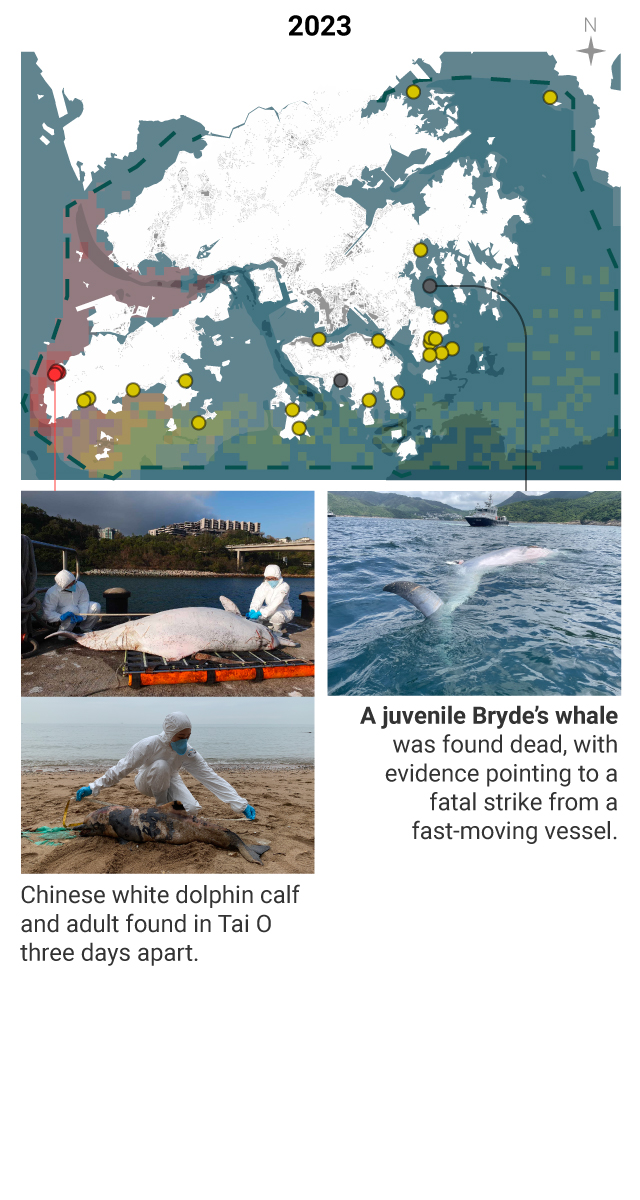
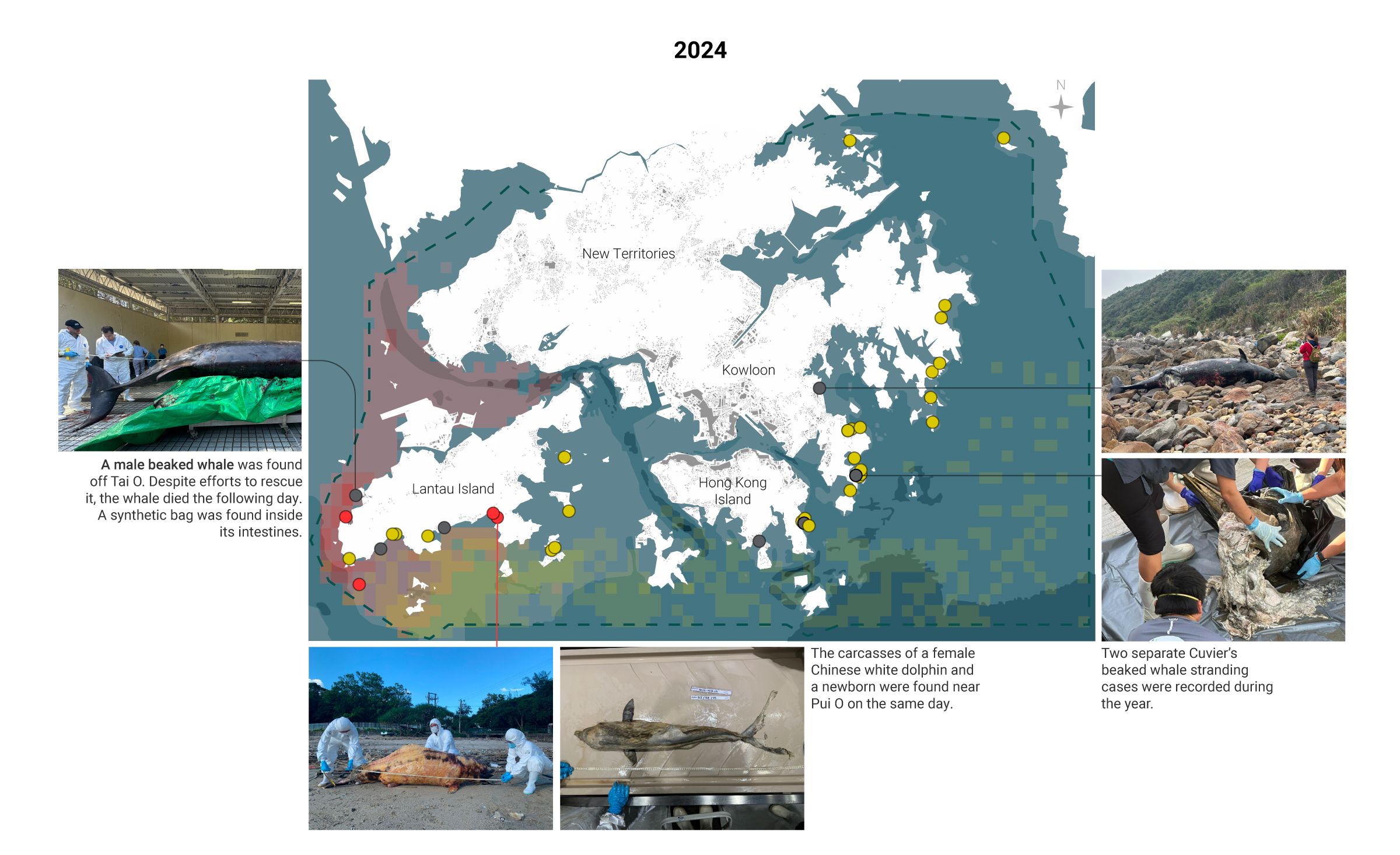

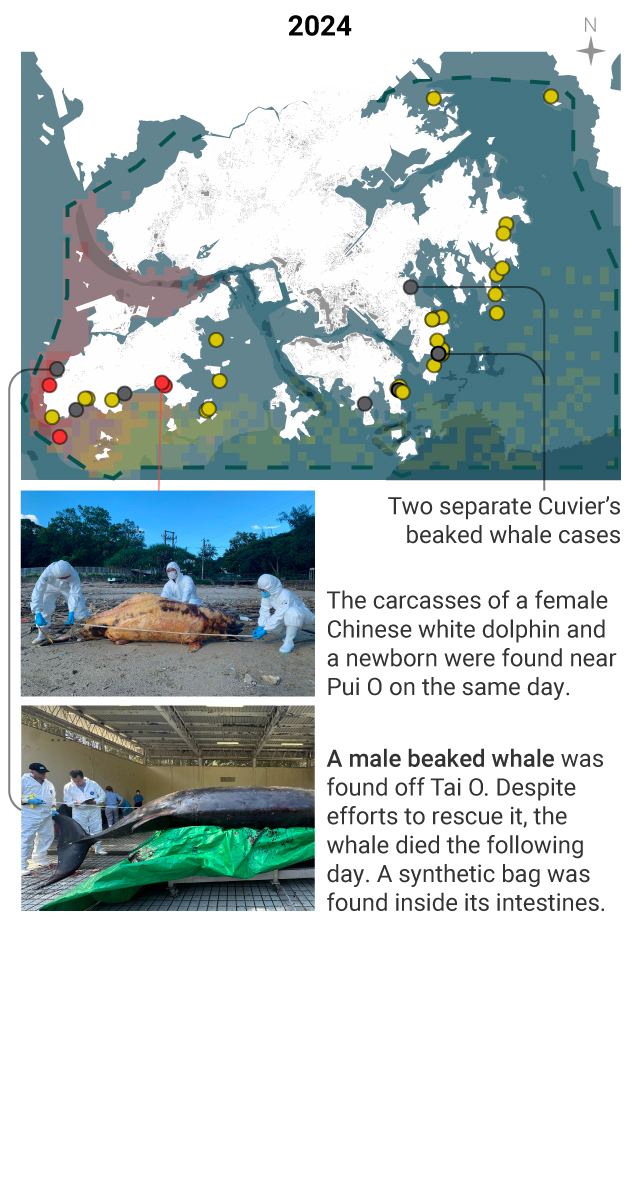


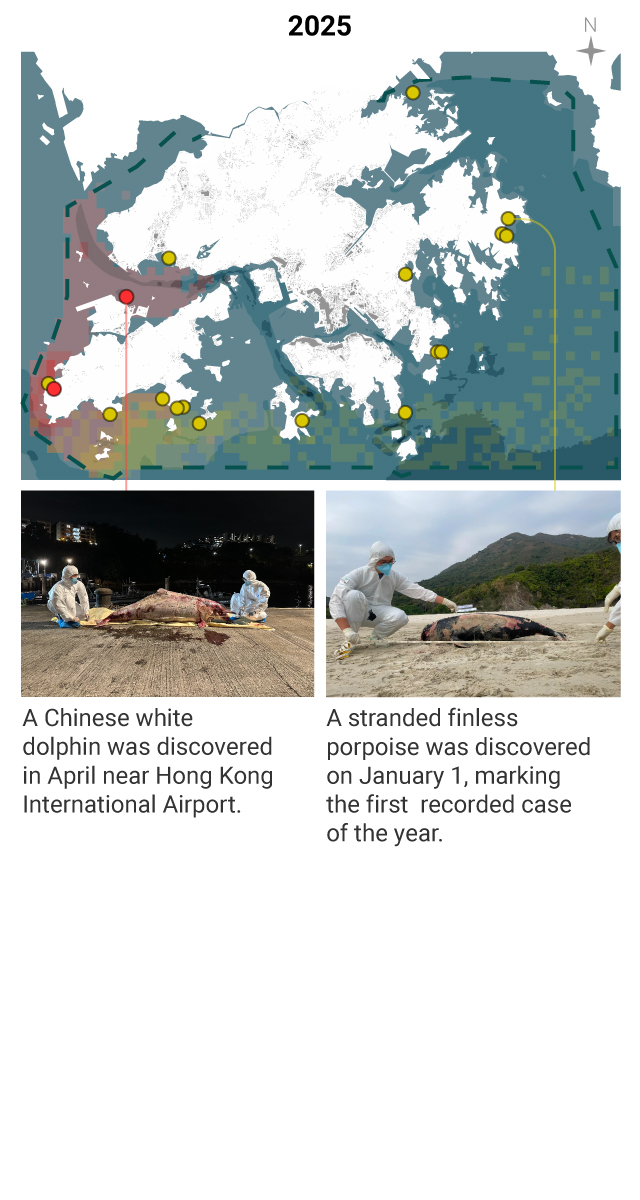
Stranding patterns
Trends from two decades of data provide insights into strandings of cetaceans in Hong Kong waters. Each dot in this section represents a case, with colours distinguishing between species.
Since 2006, a total of 675 stranding cases have been recorded:
147 Chinese white dolphins,
476 finless porpoises,
and 52 from other species.
The year 2019 saw the highest number of recorded cases, with a total of 55 stranding incidents, including 42 finless porpoises.
Between 2021 and 2023, the number of reported cases was generally lower than other recorded years. This decline was likely influenced by reduced human activities at sea and on beaches during the Covid-19 pandemic. Less fishing and boat traffic may have resulted in fewer marine mammal fatalities, while decreased beachgoer activity likely led to fewer sightings of stranded carcasses.
The number of stranded Chinese white dolphins has decreased in recent years. While this may suggest a decline in their population, it could also indicate that dolphins were moving away from monitored areas. However, threats such as reclamation activities, high-speed vessels, unnatural death, and reduced reproductive success remain significant concerns for their survival.
Non-native marine species have been observed more frequently in Hong Kong waters. Experts suggest this may be linked to global warming and the availability of abundant food sources.
Changes in water temperature can affect the distribution of marine species. Additionally, overfishing may force some deep-water species to move closer to coastal areas in search of food.
Peak stranding periods consistently occurred during winter or cooler seasons, with January recording the highest number of cases, predominantly involving finless porpoises.
This pattern may be linked to the prevalence of pathogens. However, experts were still gathering evidence to confirm the connection between temperature changes and pathogen activity, and seasonal variations in stranding cases.
While more stranding cases of finless porpoises were reported during winter and spring, Chinese white dolphins appear to adjust their distribution in summer, extending their range across Hong Kong waters, including the southern part of Lantau. The overall number of Chinese white dolphins in Hong Kong may not exhibit significant seasonal changes, as they consistently inhabit key western waters such as north Lantau and outer Deep Bay throughout the year.
After arriving at the scene of a stranding, the response team collects key data by measuring the animal’s length and recording its estimated age, gender, and level of decomposition.
The majority of stranding cases involve animals in their adult life stage, compared to the four other age groups.
Many neonatal and calf stranding cases involve Chinese white dolphins. It is estimated that nearly half of the dolphin calves born in the past two decades died within their first year or two. After a steady increase in recorded births starting in 2006, which peaked at 22 in 2011, the number dropped significantly in recent years, with only four births recorded in 2019 and 2020.
The response team assigns a rated code to each carcass after evaluating its condition. Higher numbers indicate more severe decomposition.
The majority of the carcasses discovered were in an advanced state of decomposition. Hong Kong's humidity would significantly accelerate the decomposition process, especially when combined with the warm to hot temperatures experienced for much of the year.
Only a small number of stranded animals were found alive, but most died either where they washed up or later in a rehabilitation pool. Animals with visible abnormalities or found in unsuitable habitats, such as shallow waters, were also categorised as live strandings.
Decomposition stages
The rate of decomposition can vary significantly depending on the location of the carcass (eg: in water, on a beach, or under shade). Generally, warmer climates accelerate decomposition.
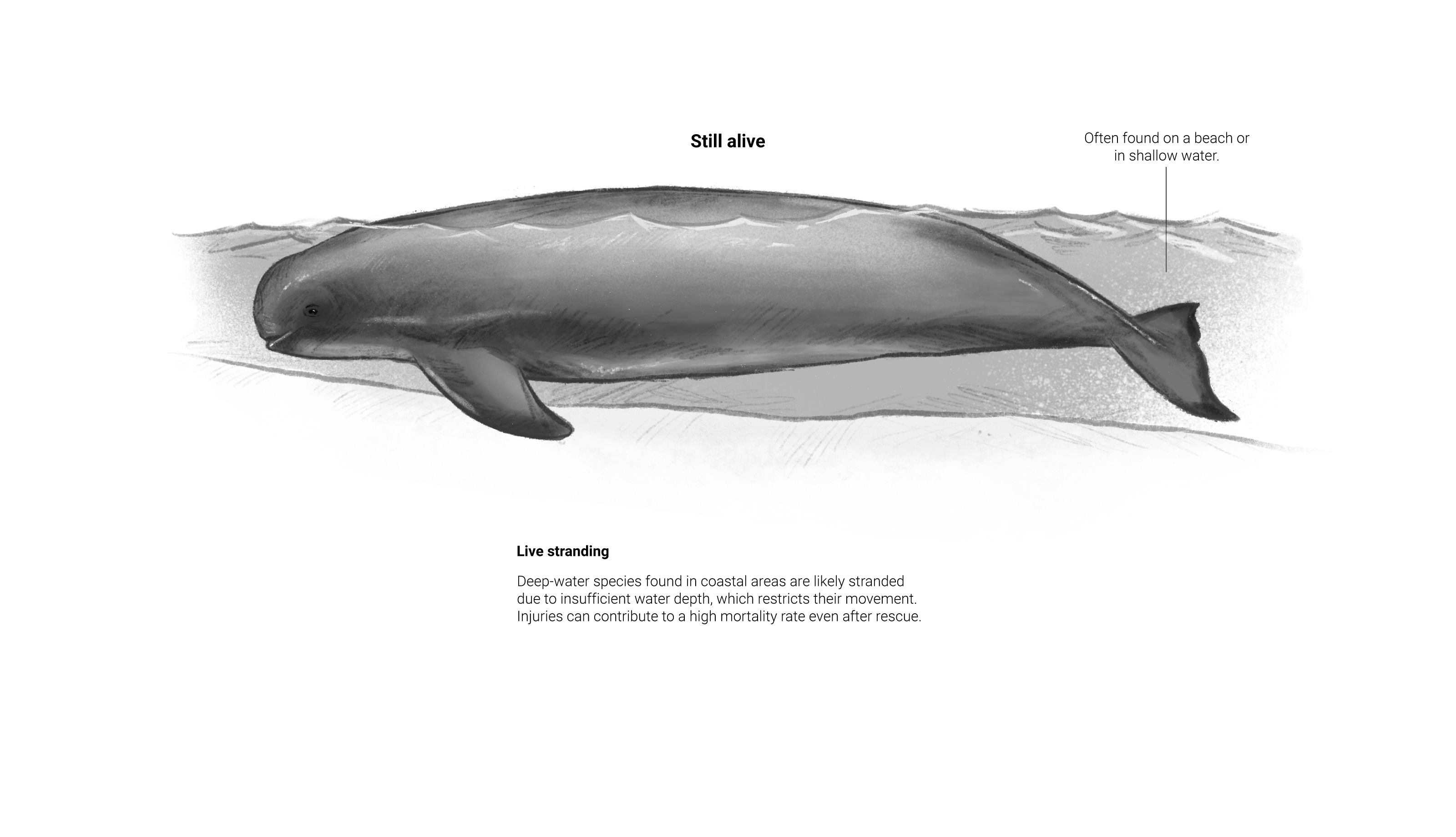








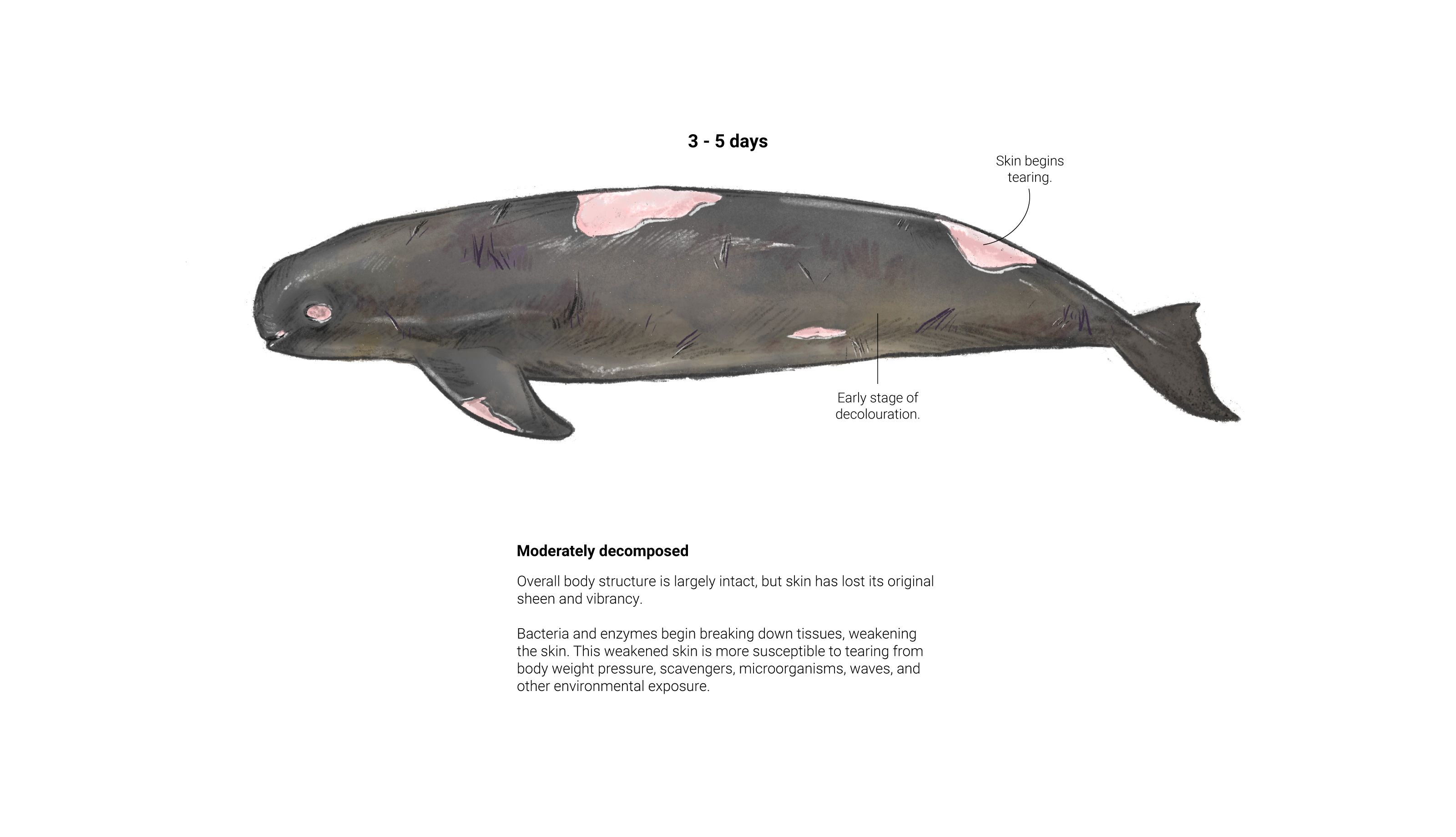


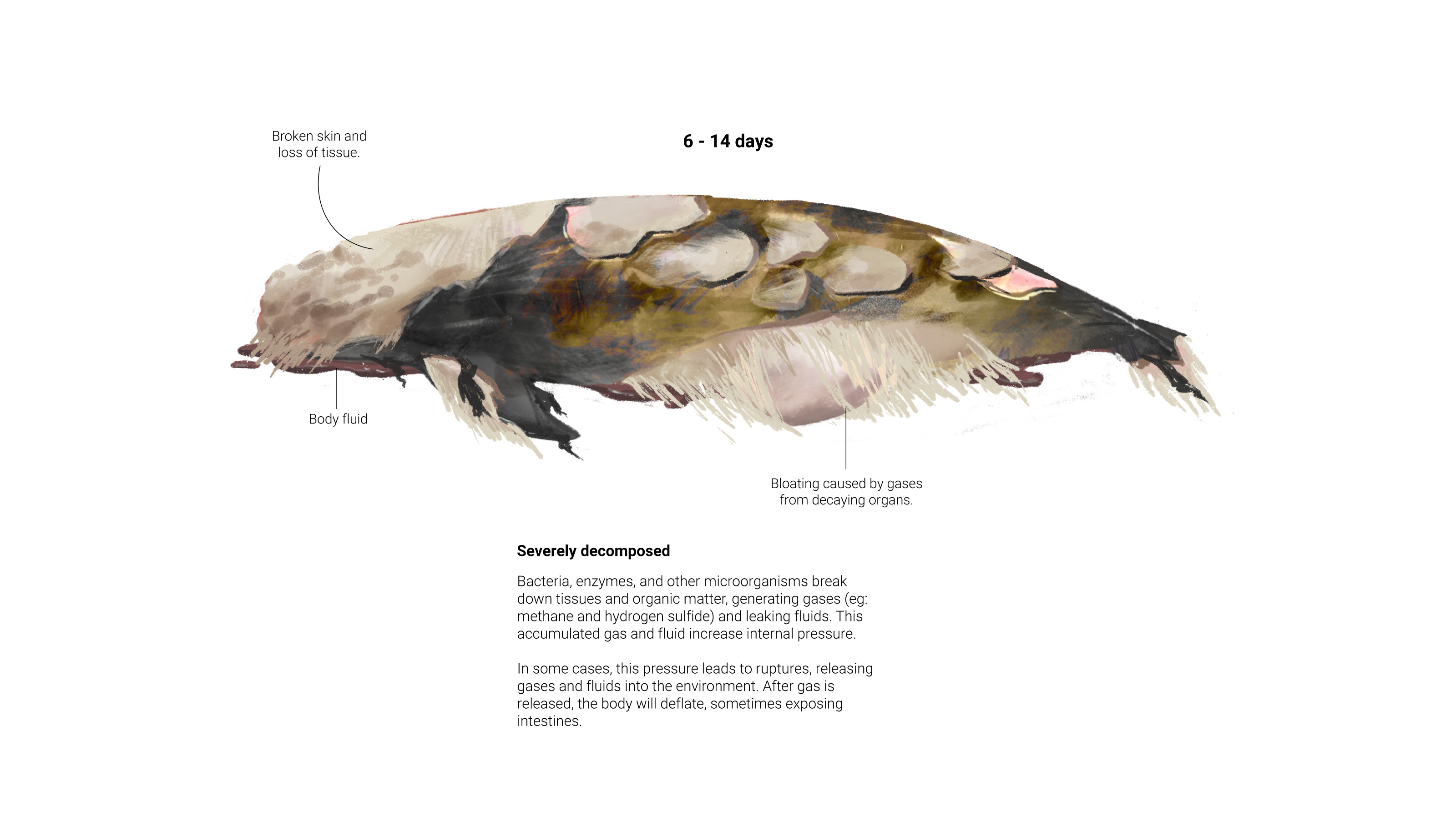

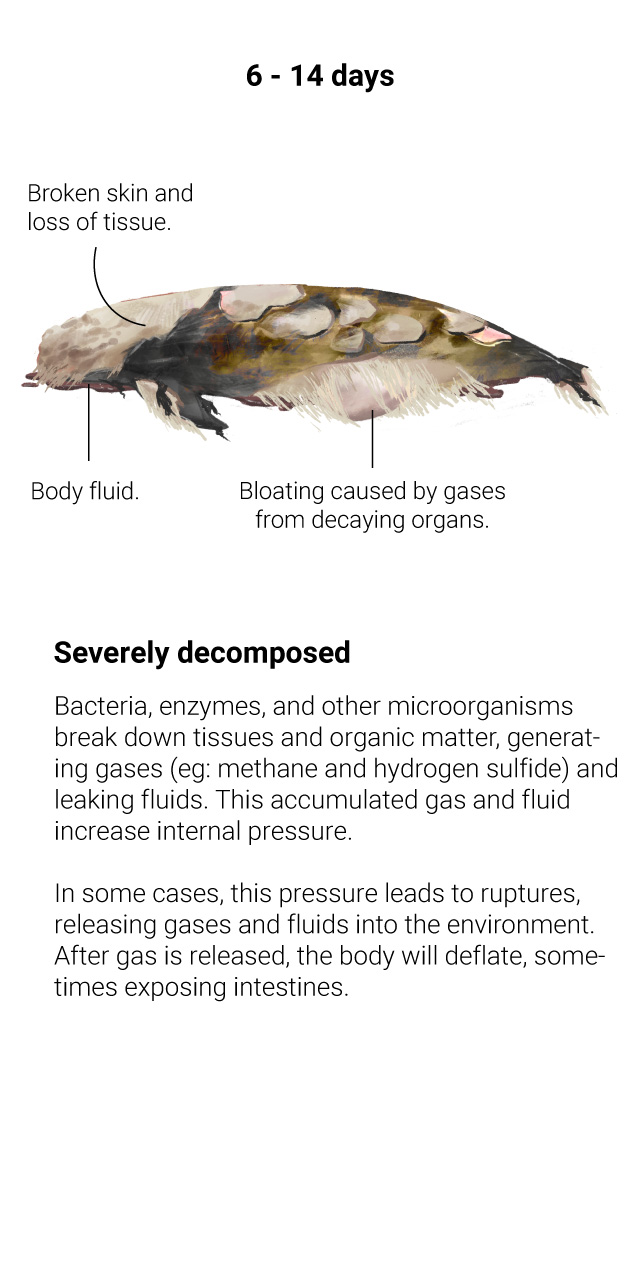
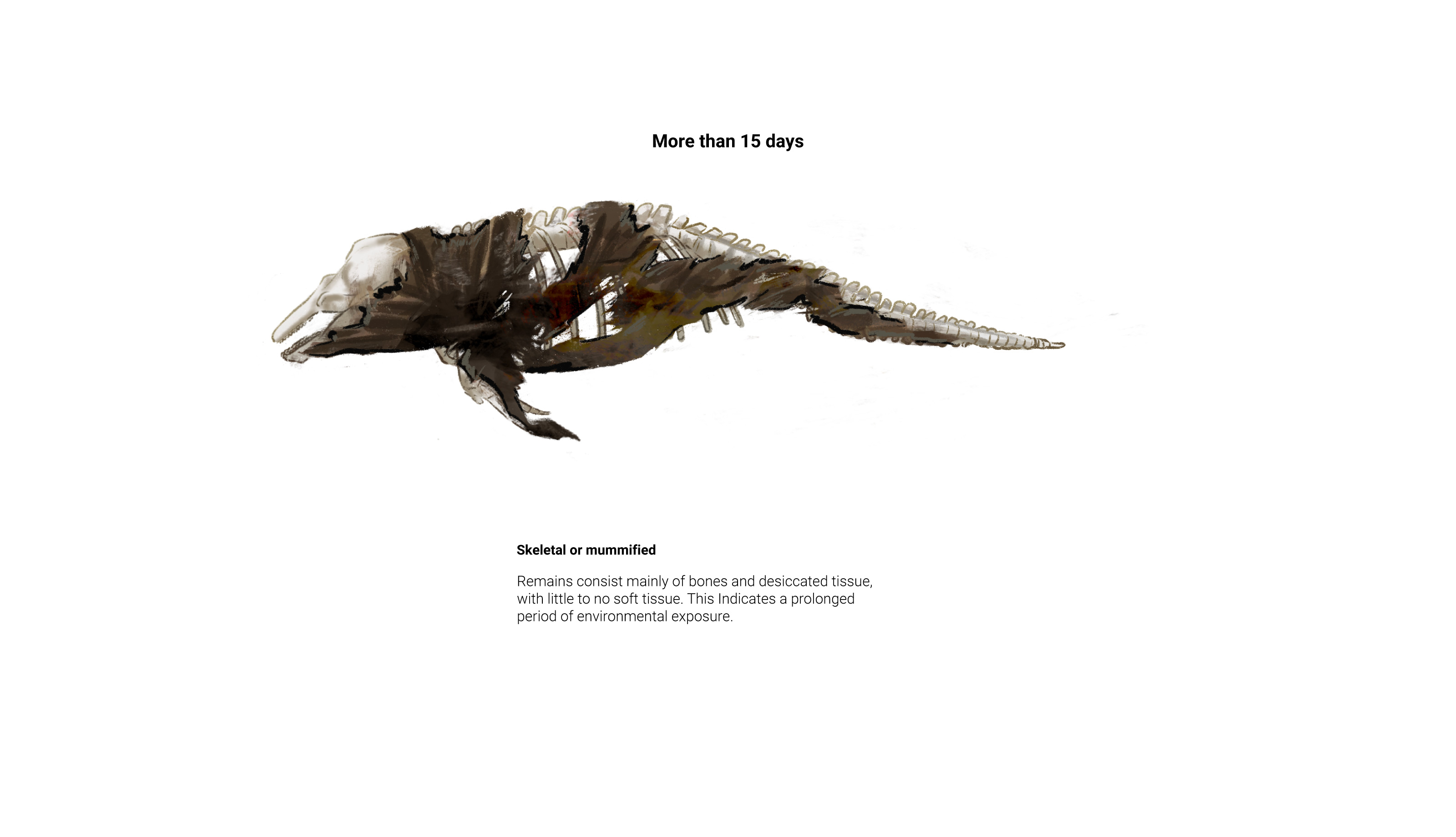

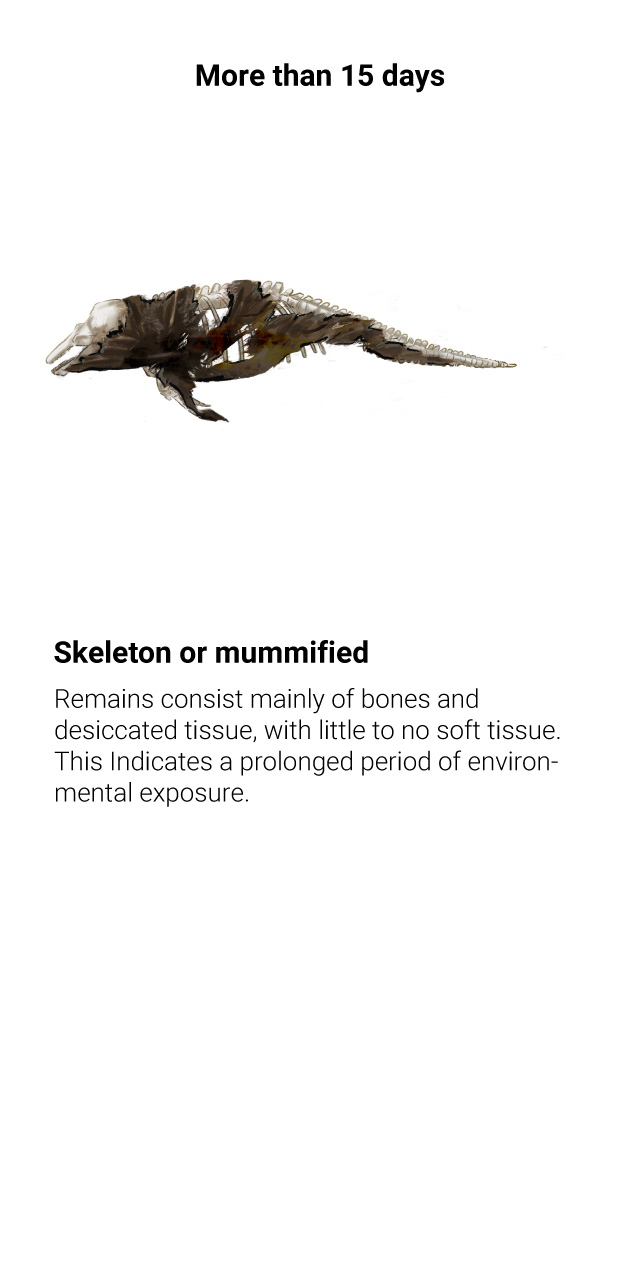
Threats to marine life in Hong Kong waters
When marine animal carcasses are found along Hong Kong coastal areas, a response team conducts a necropsy,
either at the discovery site or the Hong Kong Marine Life Stranding and Education Centre,
depending on the condition of the carcass.
The purpose of the necropsy is to determine the cause of death by identifying evidence of human interaction,
such as fishing gear entanglement and sharp wounds from vessel strikes. Natural causes,
such as respiratory diseases, drowning, and old age, are also carefully considered.
Since the Hong Kong Ocean Park Conservation Foundation began recording cetacean strandings in 2006,
approximately 30 per cent of cases have shown signs of human-caused injuries. Among cases where
a cause of death could be determined, the major human-related threats to cetaceans in Hong Kong
waters include entanglement in fishing nets, boat collisions, and infections.
Trauma caused by boats
Hong Kong is one of the busiest ports in the world, with thousands of cargo vessels arriving and departing each year.
The waters are also heavily trafficked by passenger ferries, fishing boats, and other vessels.
They generate underwater noise that disrupts marine communication and behaviour, and they discharge
wastewater containing harmful chemicals. More directly, collisions with boats can cause
severe trauma to cetaceans, often leading to fatal injuries.
Hong Kong’s busy waters

Some cetacean carcasses found were missing heads or other body parts, likely due to propeller injuries or other human interactions. The presence of undigested fish in their stomachs indicates these animals were still able to forage before death, suggesting trauma, rather than illness, was the cause of their fatalities.
The tragic end of a Bryde’s whale
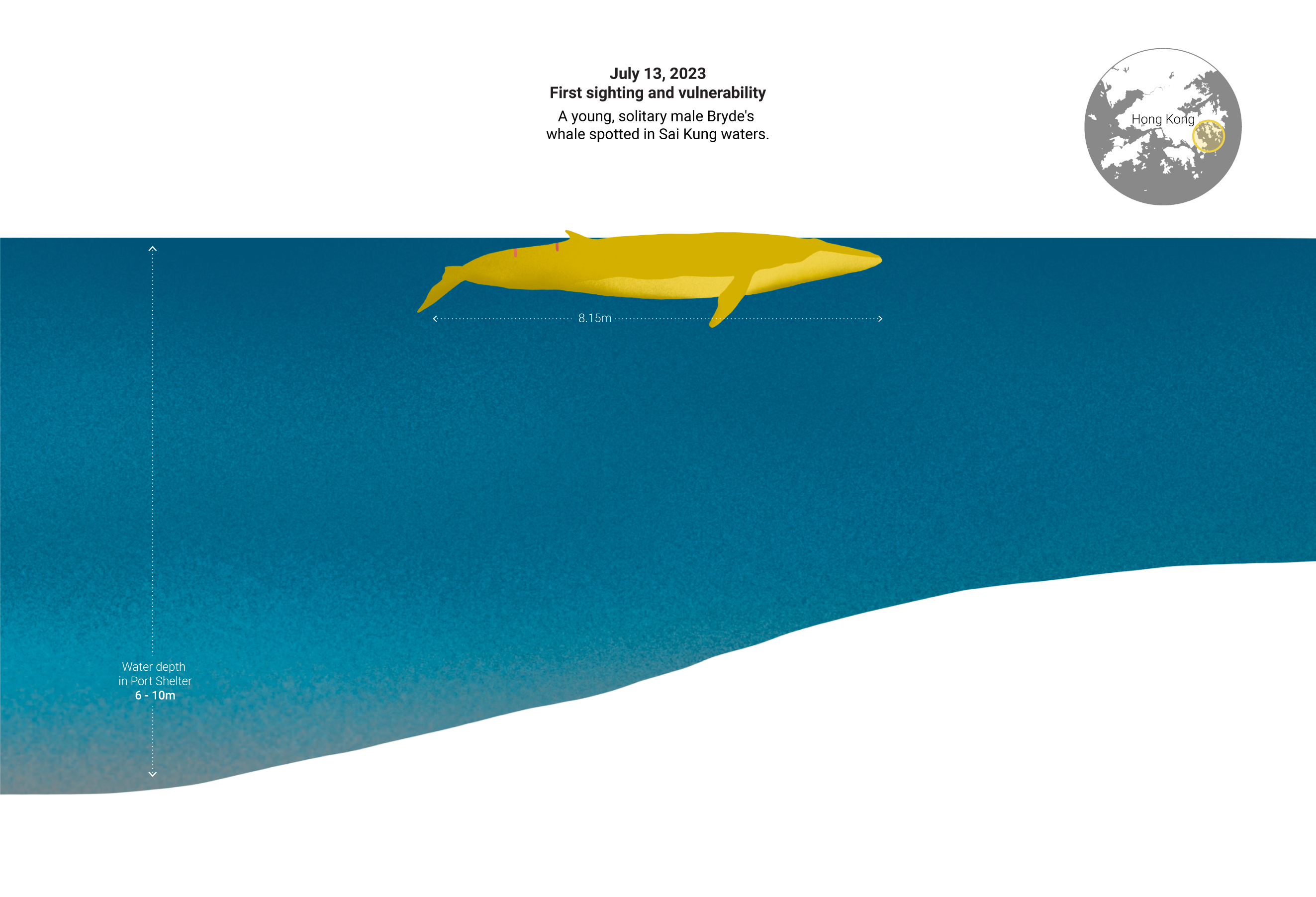

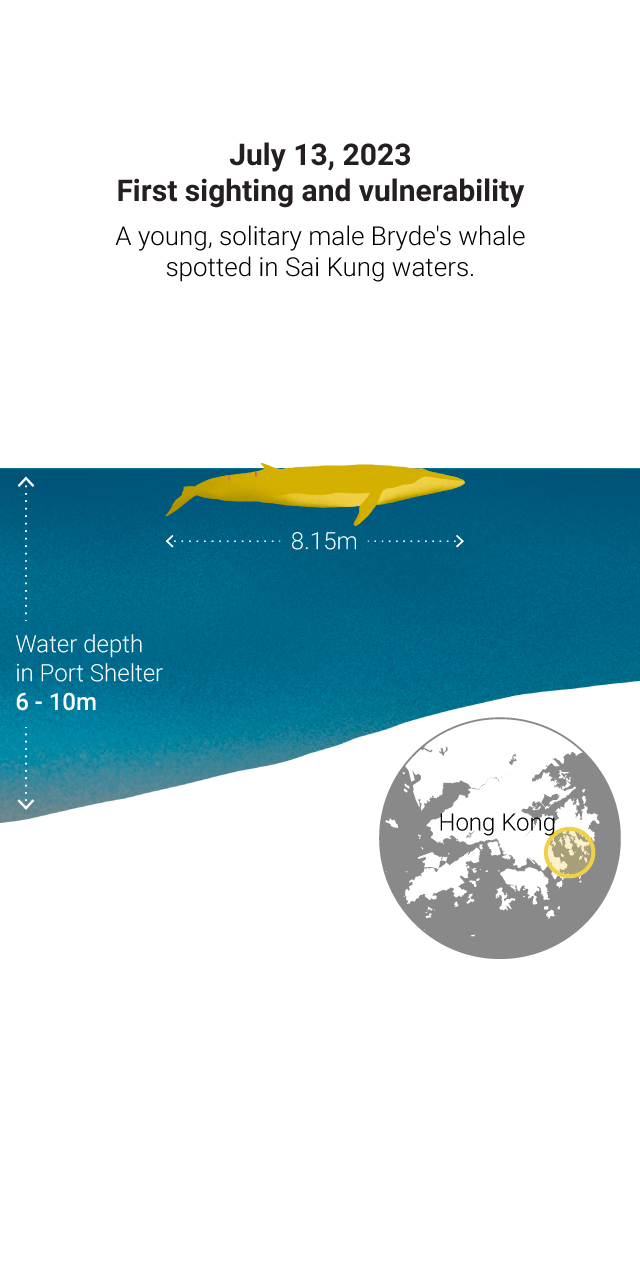



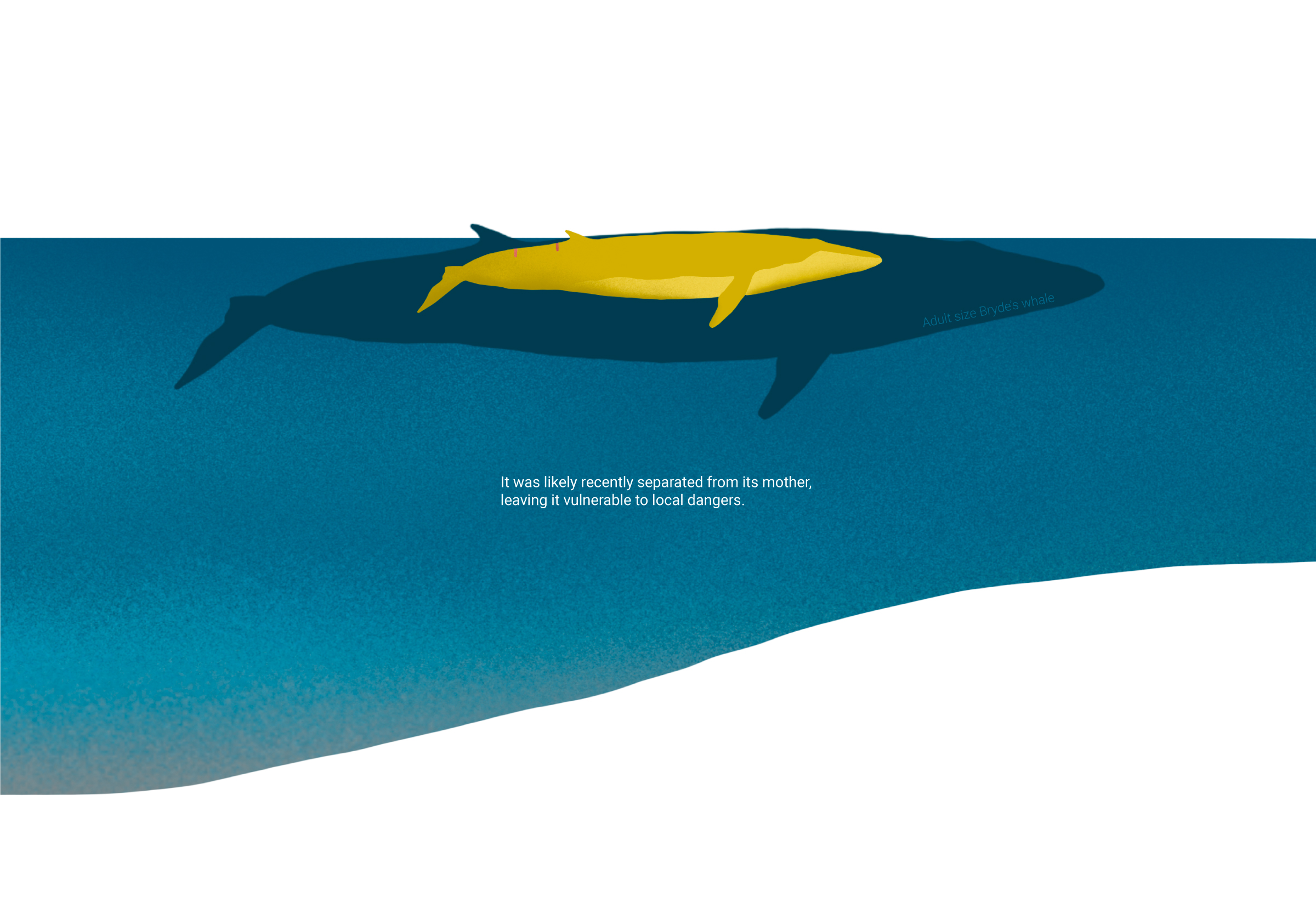

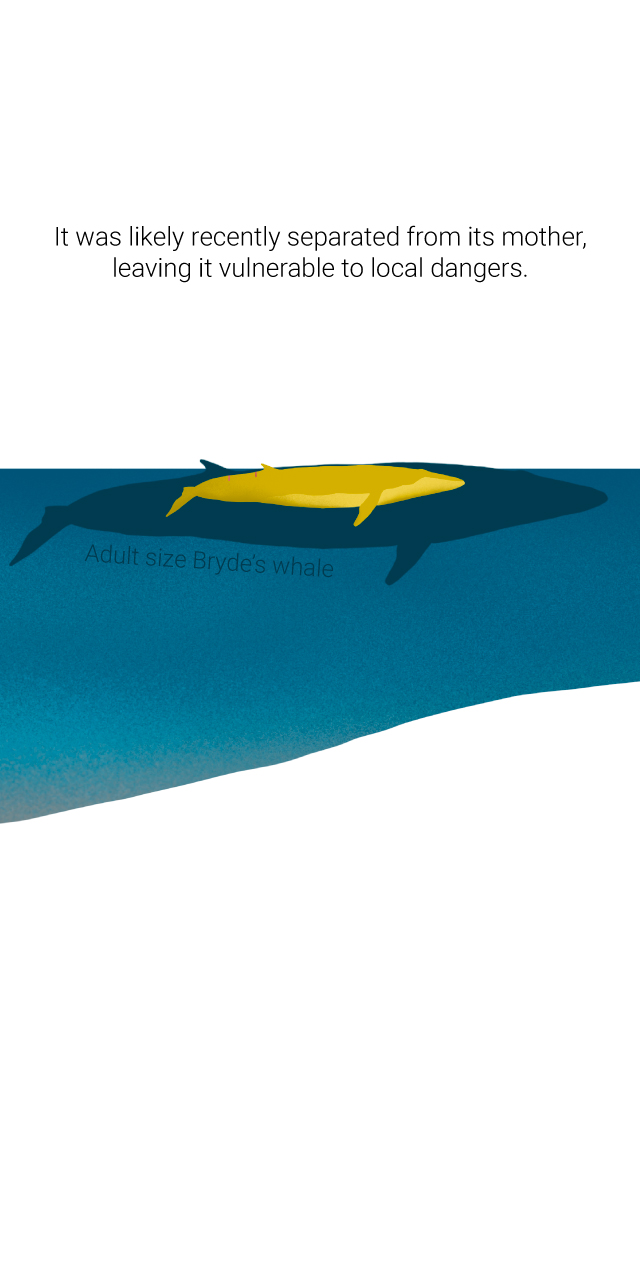


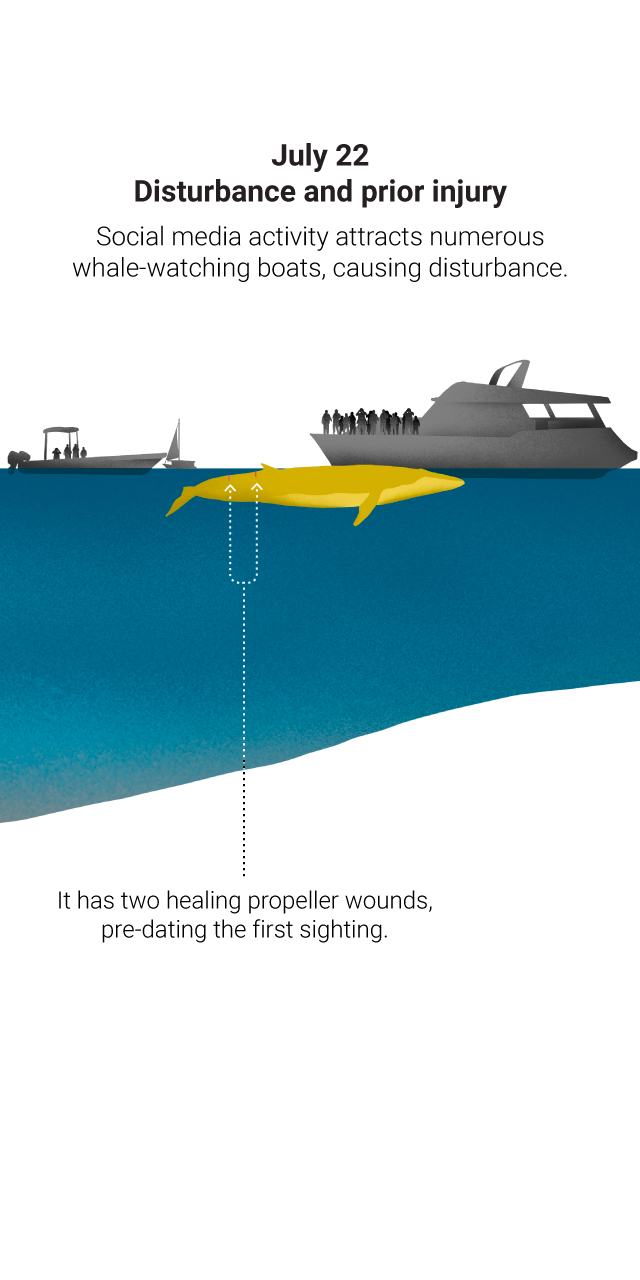
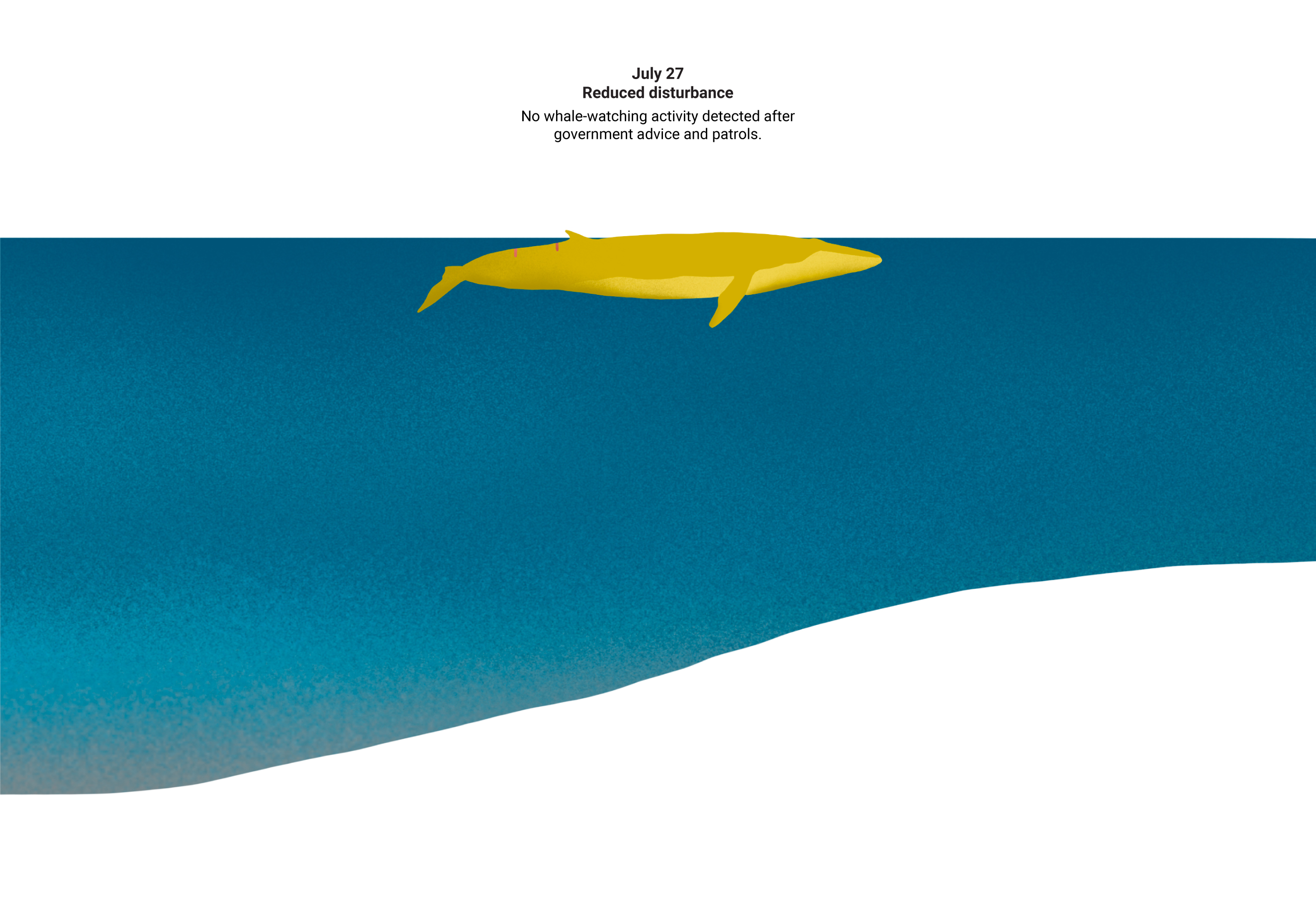





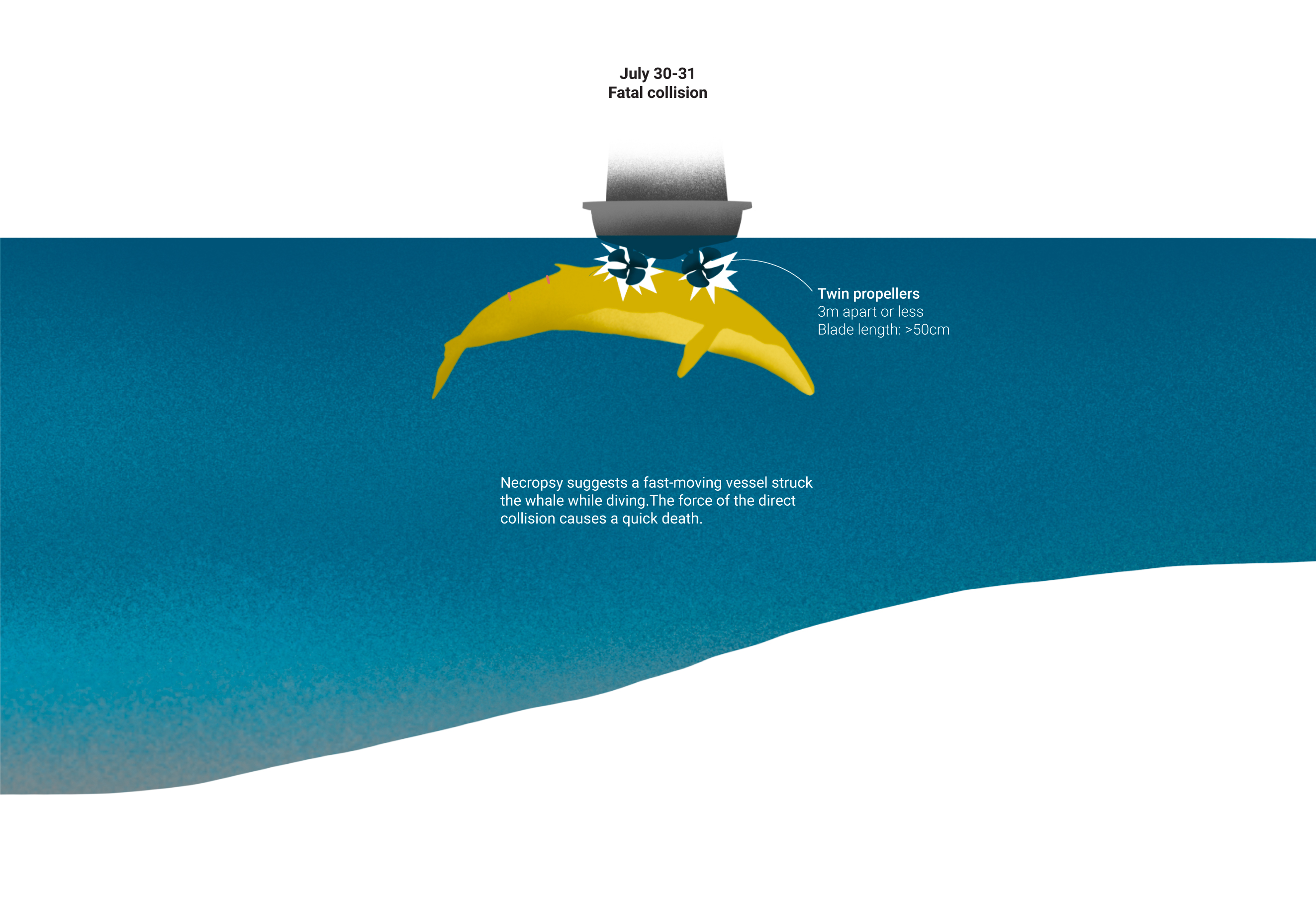

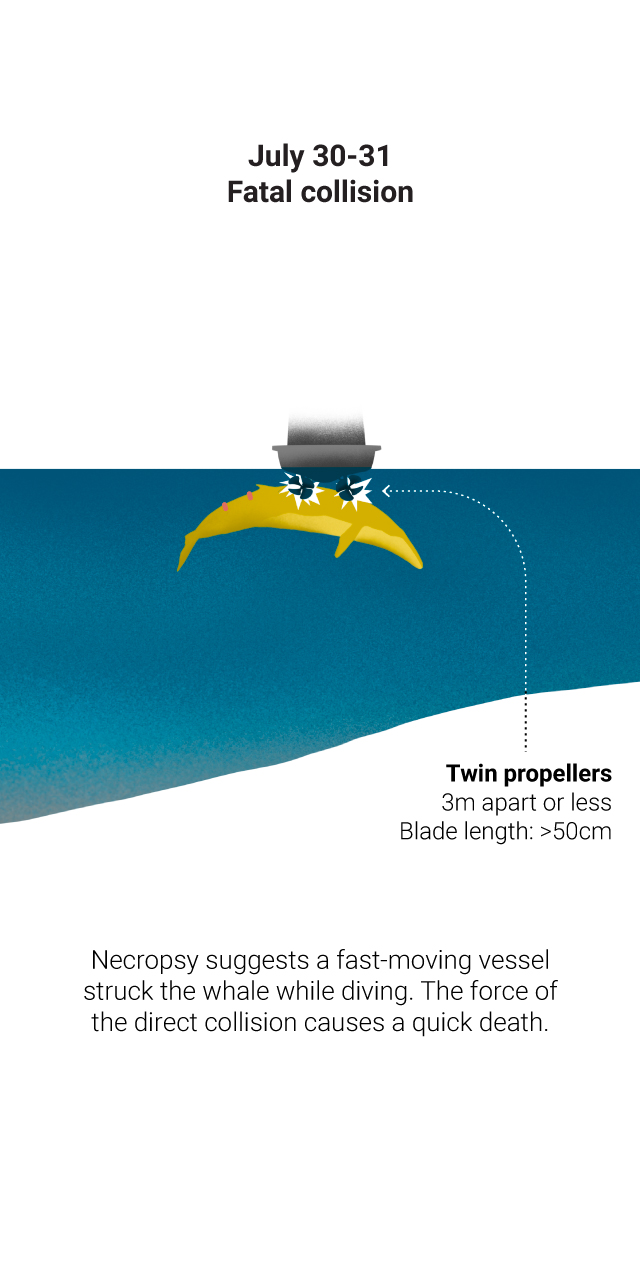
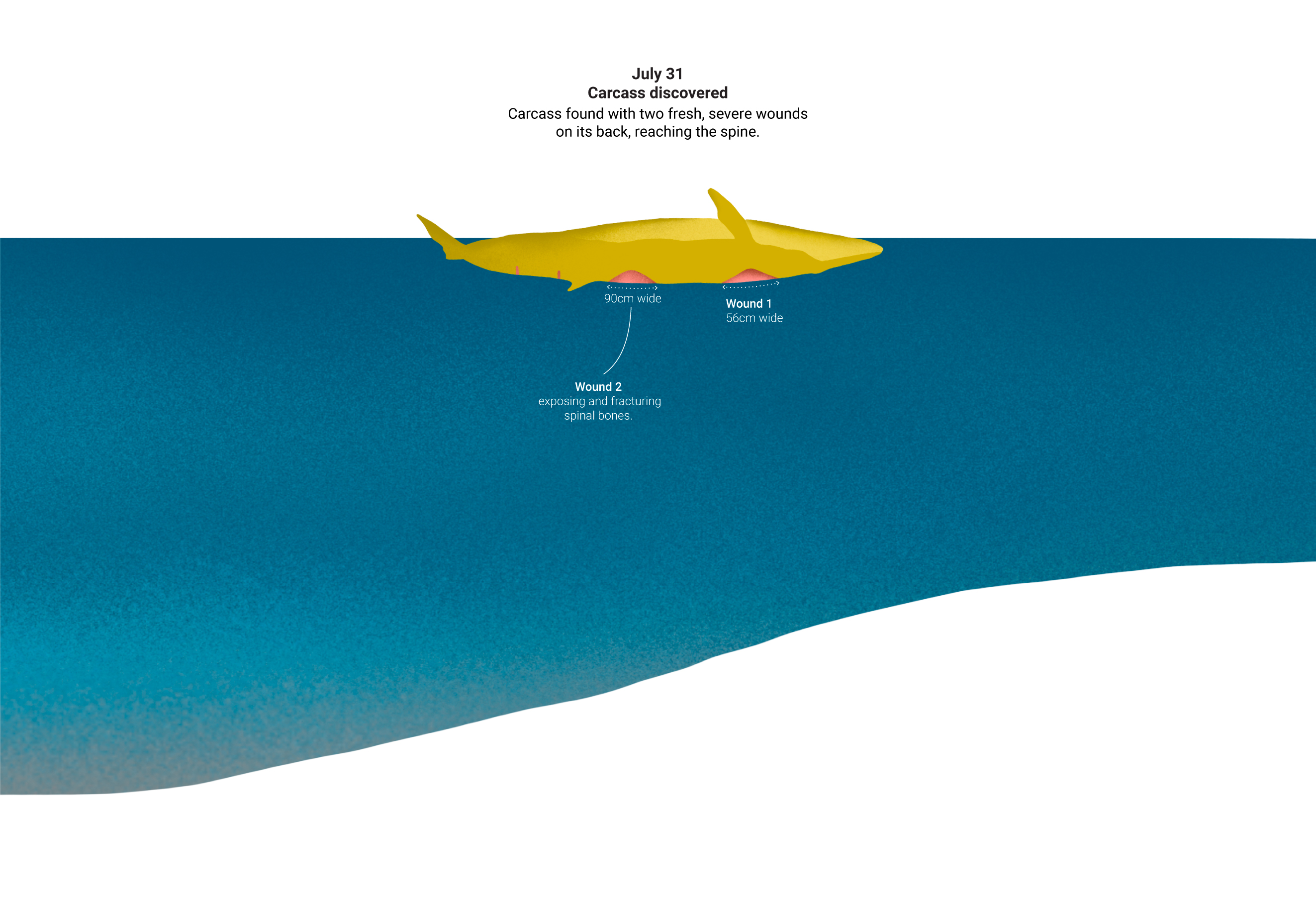

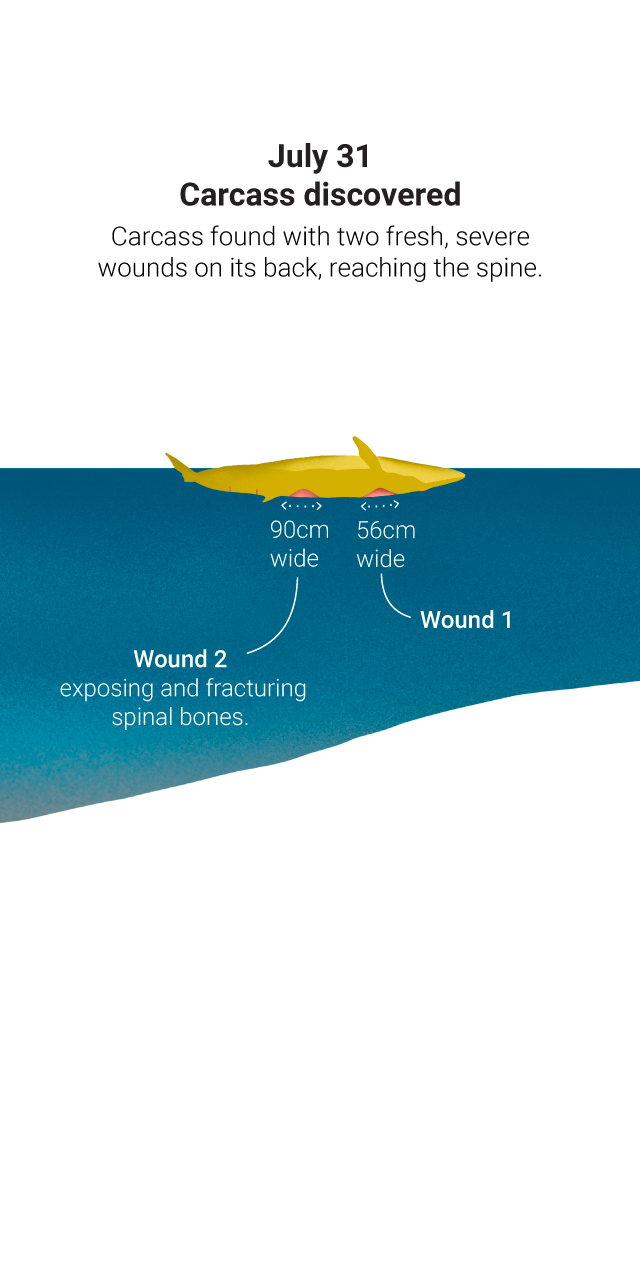
‘Ghost gear’ and fishing net dangers
Abandoned fishing gear, known as “ghost gear” (nets, pots, lines, and hooks),
is a significant problem in Hong Kong waters, ranking among the top 10 most common types of marine litter,
according to the World Wide Fund for Nature.
This deadly debris directly harms marine mammals. For example, one Chinese white dolphin was discovered
with its head and fluke ensnared in 3.5kg of abandoned fishing gear. In another instance,
a young finless porpoise drowned after becoming entangled in fishing nets.
Besides entanglement, cetaceans sometimes ingest ghost gear. When they swallow small prey caught in this debris,
indigestible and sharp objects can severely damage their digestive systems.
Response teams occasionally find fishing hooks in the stomachs of stranded animals.
Moreover, cetaceans are often drawn to the same large schools of fish that attract fishing vessels,
making them susceptible to being caught in nets. When they struggle to escape,
the nets can become entangled in their fins or beaks, restricting their movement and ability to feed.
FISHING VESSEL ACTIVITY IN HONG KONG

Pollution and infection
Recent research (The Chinese University of Hong Kong, February 2025) found unexpectedly high levels of water pollutants -
including nitrogen, E coli, and suspended solids - in Chinese white dolphin habitats. This pollution,
largely from excessive chemical fertilisers and sewage, fuels algal and plankton overgrowth, leading to marine environment deterioration.
Such water pollution has long been linked to high mortality in young dolphin calves,
with significant pollutant loads found in stranded calves in Hong Kong.
E coli levels in Chinese white dolphin habitats
Porpoises are prone to serious health issues affecting their lungs and skin.
Recent studies have revealed that 70-80 per cent of adult finless porpoises found stranded in Hong Kong
suffered from lung parasites or pneumonia caused by parasitic infections. However, researchers also noted that parasites are natural in wild animals and typically do not cause death.
Similarly, a 2010-2015 study showed that nearly half of observed Chinese white dolphins had at least one type of skin lesion,
with almost 60 per cent of those affected displaying multiple types. These cutaneous lesions and abnormal skin conditions are key indicators
of a compromised immune system in living dolphins, often linked to habitat degradation, pollution, and eutrophication from human activities.
Prevalence of skin lesions in Chinese white dolphins
Why prompt reporting matters
Early reporting allows experts to collect valuable data, gather fresh samples for research and determine cause of death more effectively. The procedure involves multiple departments. Upon receiving a stranding report, the Agriculture, Fisheries and Conservation Department of Hong Kong refers the cases to the Ocean Park Conservation Foundation. The foundation subsequently arranges carcass retrieval, transporting the bodies to the Aquatic Animal Virtopsy Lab at the City University of Hong Kong for virtopsy, and to Ocean Park for conventional necropsy.

Associate Creative Director Marcelo Duhalde
Edited by Andrew London
Additional web development Catherine Ma, Rocio Marquez
Photos: Ocean Park Conservation Foundation Hong Kong (OPCFHK), HZMB - Transport and Logistics Bureau, SCMP
Sources: South China Morning Post archives, Ocean Park Conservation Foundation Hong Kong (OPCFHK), Agriculture, Fisheries, and Conservation Department, International Union for Conservation of Nature and Natural Resources (IUCN), UK Whale and Dolphin Conservation, US National Oceanic and Atmospheric Administration, International Whaling Commission, Environmental Protection Department, Global Maritime Traffic Density Service (GMTDS) - National Geospatial-Intelligence Agency, Hong Kong Ocean Park Conservation Foundation, The Chinese University of Hong Kong, University of Exeter, Hong Kong Dolphin Conservation Society, Aquatic Animal Virtopsy Lab at City University of Hong Kong, Cetacea Research Institute at the University of Hong Kong, Marine Ecology Enhancement Fund (MEEF)
Hi, Internet Explorer user!
This site has some features that may not be compatlibe with your browser. Should you wish to view content, switch browsers to either Google Chrome or Mozilla Firefox to get an awesome experience
